Kings And Queens Of England on:
[Wikipedia]
[Google]
[Amazon]
 This list of kings and reigning queens of the Kingdom of England begins with
This list of kings and reigning queens of the Kingdom of England begins with
Alfred the Great
c. 886
–
26 October 899
''(13 years)'' , , 849
, 849
Son of
and Osburh , Ealhswith of Gainsborough
868
5 children , 26 October 899
Aged about 50 , Son of
Treaty of Wedmore , - , Edward the Elder
26 October 899
–
17 July 924
''()'' ,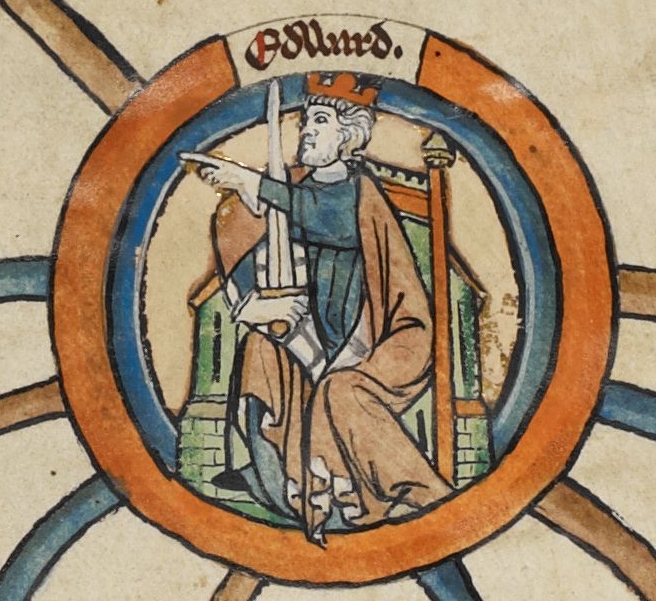 ,
,
Son of Alfred
and Ealhswith ,
2 children
8 children
Eadgifu of Kent
4 children , 17 July 924
Aged about 50 , Son of Alfred , - , Æthelstan
Æthelstan the Glorious
924
–
27 October 939
''(14–15 years)'' ,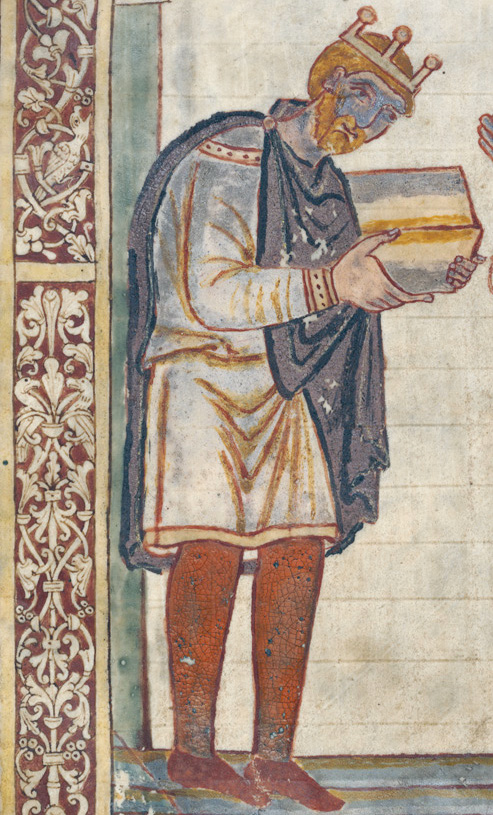 , 894
, 894
Son of Edward the Elder
and
Aged about 45 , Son of Edward the Elder , - ,
Edmund the Magnificent
27 October 939
–
26 May 946
''()'' ,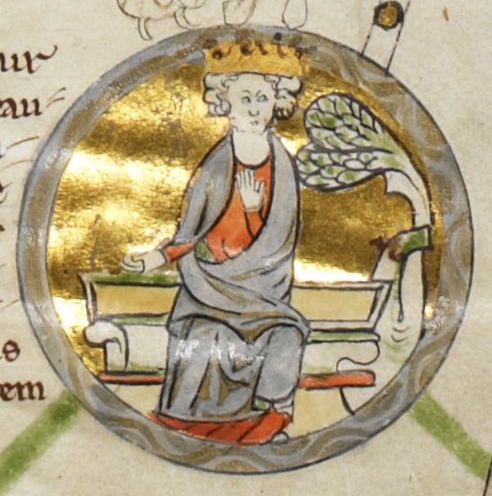 ,
,
Son of Edward the Elder
and Eadgifu of Kent ,
2 sons
Æthelflæd of Damerham
944
No children , 26 May 946
Pucklechurch
Killed in a brawl aged about 25 , Son of Edward the Elder , - , Eadred
26 May 946
–
23 November 955
''()'' , ,
,
Son of Edward the Elder
and Eadgifu of Kent , Unmarried , 23 November 955
Frome
Aged about 32 , Son of Edward the Elder , - , Eadwig
Eadwig All-Fair
23 November 955
–
1 October 959
''()'' , ,
,
Son of
and
No verified children , 1 October 959
Aged about 19 , Son of
1 October 959
–
8 July 975
''()'' , ,
,
Wessex
Son of Edmund I
and Ælfgifu of Shaftesbury , Æthelflæd
1 son
Ælfthryth
2 sons , 8 July 975
Aged 31 , Son of Edmund I , - , Edward the Martyr
8 July 975
–
18 March 978
''()'' ,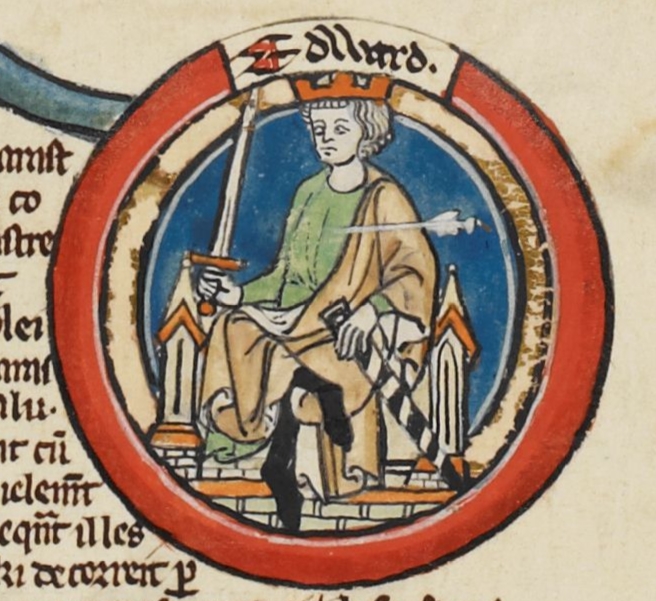 ,
,
Son of Edgar the Peaceful
and Æthelflæd , Unmarried , 18 March 978
Corfe Castle
Murdered aged about 16 , Son of Edgar the Peaceful , - , ''(1st reign)''
Æthelred the Unready
18 March 978
–
1013
''(34–35 years)'' , ,
,
Son of Edgar the Peaceful
and Ælfthryth , Ælfgifu of York
991
9 children
Emma of Normandy
1002
3 children , 23 April 1016
London
Aged about 48 , Son of Edgar the Peaceful
Sweyn Forkbeard
25 December 1013
–
3 February 1014
''()'' , , 17 April 963
, 17 April 963
Denmark
Son of Harald Bluetooth
and either Tove or Gunhild , Gunhild of Wenden
7 children
Sigrid the Haughty
1 daughter , 3 February 1014
Gainsborough
Aged 50 , Right of conquest
Æthelred the Unready
3 February 1014
–
23 April 1016
''()'' , ,
,
Son of Edgar the Peaceful
and Ælfthryth , Ælfgifu of York
991
9 children
Emma of Normandy
1002
3 children , 23 April 1016
London
Aged about 48 , Son of Edgar the Peaceful , - , Edmund Ironside
23 April 1016
–
30 November 1016
''()'' , ,
,
Son of Æthelred
and Ælfgifu of York , Edith of East Anglia
2 children , 30 November 1016
Glastonbury
Aged 26 , Son of Æthelred
Cnut the Great
18 October 1016
–
12 November 1035
''()'' , ,
,
Son of
and Gunhilda of Poland , Ælfgifu of Northampton
2 sons
Emma of Normandy
1017
2 children , 12 November 1035
Shaftesbury
Aged about 40 , Son of Sweyn
Treaty of Deerhurst , - , Harold Harefoot
12 November 1035
–
17 March 1040
''()'' ,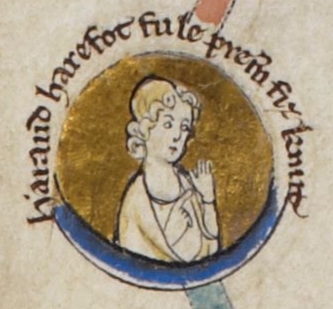 ,
,
Son of Cnut the Great
and Ælfgifu of Northampton , , 17 March 1040
Oxford
Aged about 24 , Son of Cnut the Great , - ,
17 March 1040
–
8 June 1042
''()'' , , 1018
, 1018
Son of Cnut the Great
and Emma of Normandy , Unmarried , 8 June 1042
Aged about 24 , Son of Cnut the Great
8 June 1042
–
5 January 1066
''()'' , ,
,
Islip
Son of Æthelred
and Emma of Normandy , Edith of Wessex
23 January 1045
No children , 5 January 1066
Westminster Palace
Aged about 63 , Son of Æthelred
Harold Godwinson
6 January 1066
–
14 October 1066
''()'' , ,
,
Son of
and Gytha Thorkelsdóttir ,
5 children
Ealdgyth
2 sons , 14 October 1066
Hastings
Died in the Battle of Hastings aged 44 , Supposedly named heir by
Elected by the Witenagemot
William the Conqueror
25 December 1066
–
9 September 1087
''()'' ,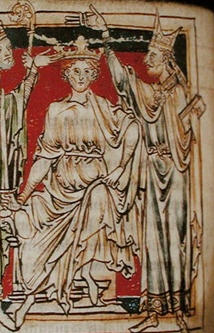 ,
,
Son of
and
Normandy
1053
9 children , 9 September 1087
Aged about 59 , Supposedly named heir in 1052 by
First cousin once removed of Edward the Confessor
Right of conquest , - , William II
William Rufus
26 September 1087
–
2 August 1100
''()'' , ,
,
Normandy
Son of William the Conqueror
and Matilda of Flanders , Unmarried , 2 August 1100
New Forest
Shot with an arrow aged 44 , Son of William I
Granted the Kingdom of England over elder brother Robert Curthose , - , Henry I
Henry Beauclerc
5 August 1100
–
1 December 1135
''()'' , , September 1068
, September 1068
Selby
Son of William the Conqueror
and Matilda of Flanders , Matilda of Scotland
Westminster Abbey
11 November 1100
2 children
Windsor Castle
29 January 1121
No children , 1 December 1135
Saint-Denis-en-Lyons
Aged 67 , Son of William I
Seizure of the Crown (from Robert Curthose)
Stephen of Blois
22 December 1135
–
25 October 1154
''()'' , ,
,
Blois
Son of Stephen II of Blois
and Adela of Normandy , Matilda of Boulogne
Westminster
1125
6 children , 25 October 1154
Dover Castle
Aged about 58 , Grandson of William I
Appointmentusurpation Count Eustace IV of Boulogne (c. 1130 – 17 August 1153) was appointed co-king of England by his father, King Stephen, on 6 April 1152, in order to guarantee his succession to the throne (as was the custom in France, but not in England). The Pope and the Church would not agree to this, and Eustace was not crowned. Eustace died the next year aged 23, during his father's lifetime, and so never became king in his own right.
Henry Curtmantle
19 December 1154
–
6 July 1189
''()'' , ,
,  , 5 March 1133
, 5 March 1133
Son of Geoffrey V of Anjou
and Matilda , Eleanor of Aquitaine
Bordeaux Cathedral
18 May 1152
8 children , 6 July 1189
Chinon
Aged 56 , Grandson of Henry I
Treaty of Wallingford , - , colspan=99 , Henry II named his son, Henry the Young King (1155–1183), as co-ruler with him but this was a Norman custom of designating an heir, and the younger Henry did not outlive his father and rule in his own right, so he is not counted as a monarch on lists of kings. , - , Richard I
Richard the Lionheart
3 September 1189
–
6 April 1199
''()'' ,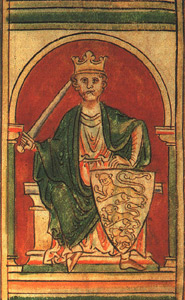 , rowspan=2 ,
, rowspan=2 ,  , 8 September 1157
, 8 September 1157
Beaumont Palace
Son of Henry II
and Eleanor of Aquitaine , Berengaria of Navarre
Limassol
12 May 1191
No children , 6 April 1199
Shot by a
John Lackland
27 May 1199
–
19 October 1216
''()'' , , 24 December 1166
, 24 December 1166
Beaumont Palace
Son of Henry II
and Eleanor of Aquitaine , Isabel of Gloucester
Marlborough Castle
29 August 1189
No children
Isabella of Angoulême
Bordeaux Cathedral
24 August 1200
5 children , 19 October 1216
Newark-on-Trent
Aged 49 , Son of Henry II
Nomination
Proximity of blood
Henry of Winchester
28 October 1216
–
16 November 1272
''()'' , , rowspan=3 ,
, rowspan=3 ,  , 1 October 1207
, 1 October 1207
Winchester Castle
Son of John
and Isabella of Angoulême ,
14 January 1236
5 children , 16 November 1272
Westminster Palace
Aged 65 , Son of John
Primogeniture , - ,
Edward Longshanks
20 November 1272
–
7 July 1307
''()'' , , 17 June 1239
, 17 June 1239
Son of Henry III
and
18 October 1254
16 children
Margaret of France
Canterbury
10 September 1299
3 children , 7 July 1307
Burgh by Sands
Aged 68 , Son of Henry III
Primogeniture , - ,
Edward of Caernarfon
8 July 1307
–
Abdicated 20 January 1327
''()'' ,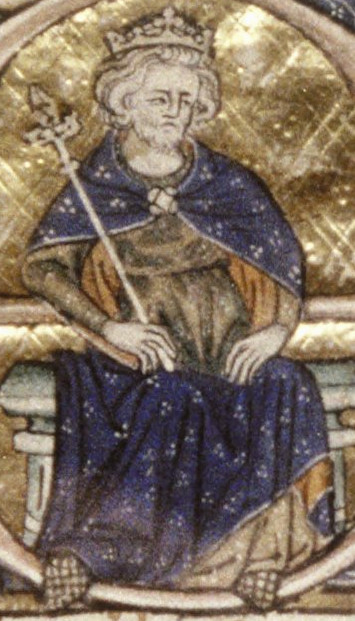 , 25 April 1284
, 25 April 1284
Son of
and
Boulogne Cathedral
24 January 1308
4 children , 21 September 1327
Berkeley Castle
Murdered aged 43 , Son of
Primogeniture , - ,
Edward of Windsor
25 January 1327
–
21 June 1377
''()'' ,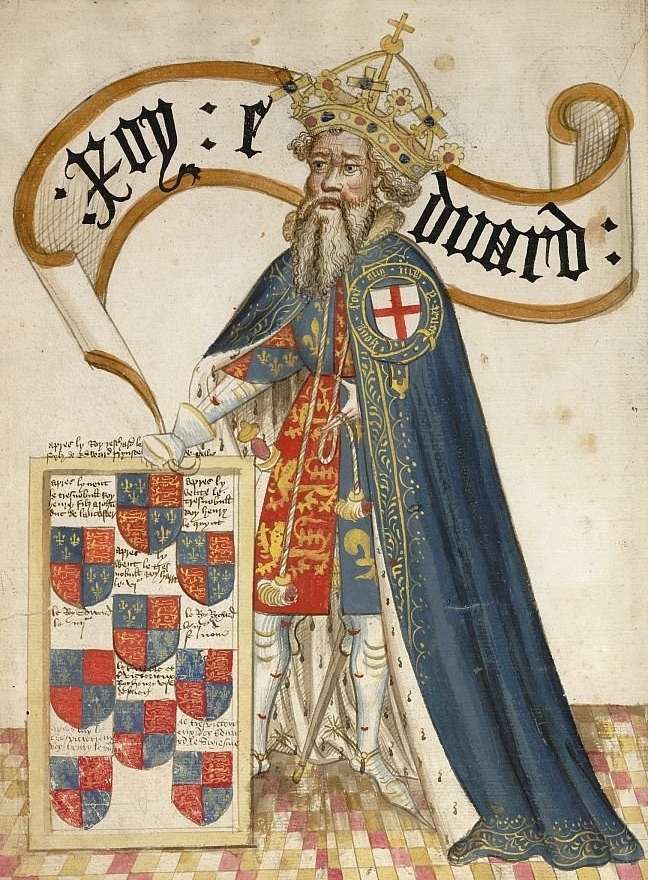 ,
, 

, 13 November 1312
Windsor Castle
Son of
and Isabella of France , Philippa of Hainault
York Minster
25 January 1328
14 children , 21 June 1377
Sheen Palace
Aged 64 , Son of
Primogeniture , - ,
Richard of Bordeaux
22 June 1377
–
29 September 1399
''()'' , ,
,  , 6 January 1367
, 6 January 1367
Bordeaux
Son of Edward the Black Prince
and Joan of Kent ,
14 January 1382
No children
Isabella of Valois
4 November 1396
No children , 14 February 1400
Pontefract Castle
Aged 33 , Grandson of
Primogeniture
Henry of Bolingbroke
30 September 1399
–
20 March 1413
''()'' ,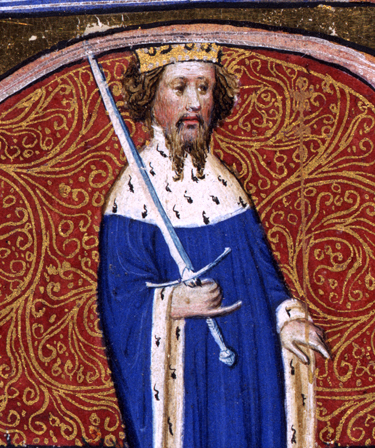 ,
, 

, April 1367
Bolingbroke Castle
Son of
and Blanche of Lancaster , Mary de Bohun
27 July 1380
6 children
Joanna of Navarre
Winchester Cathedral
7 February 1403
No children , 20 March 1413
Westminster Abbey
Aged 45 , Grandson heir male of
Usurpation , - , Henry V
Henry of Monmouth
21 March 1413
–
31 August 1422
''()'' , ,
,  , 16 September 1386
, 16 September 1386
Monmouth Castle
Son of Henry IV
and Mary de Bohun , Catherine of Valois
Troyes Cathedral
2 June 1420
1 son , 31 August 1422
Aged 35 , Son of Henry IV
Agnatic primogeniture , - , ''(1st reign)''
Henry VI
1 September 1422
–
4 March 1461
''()'' ,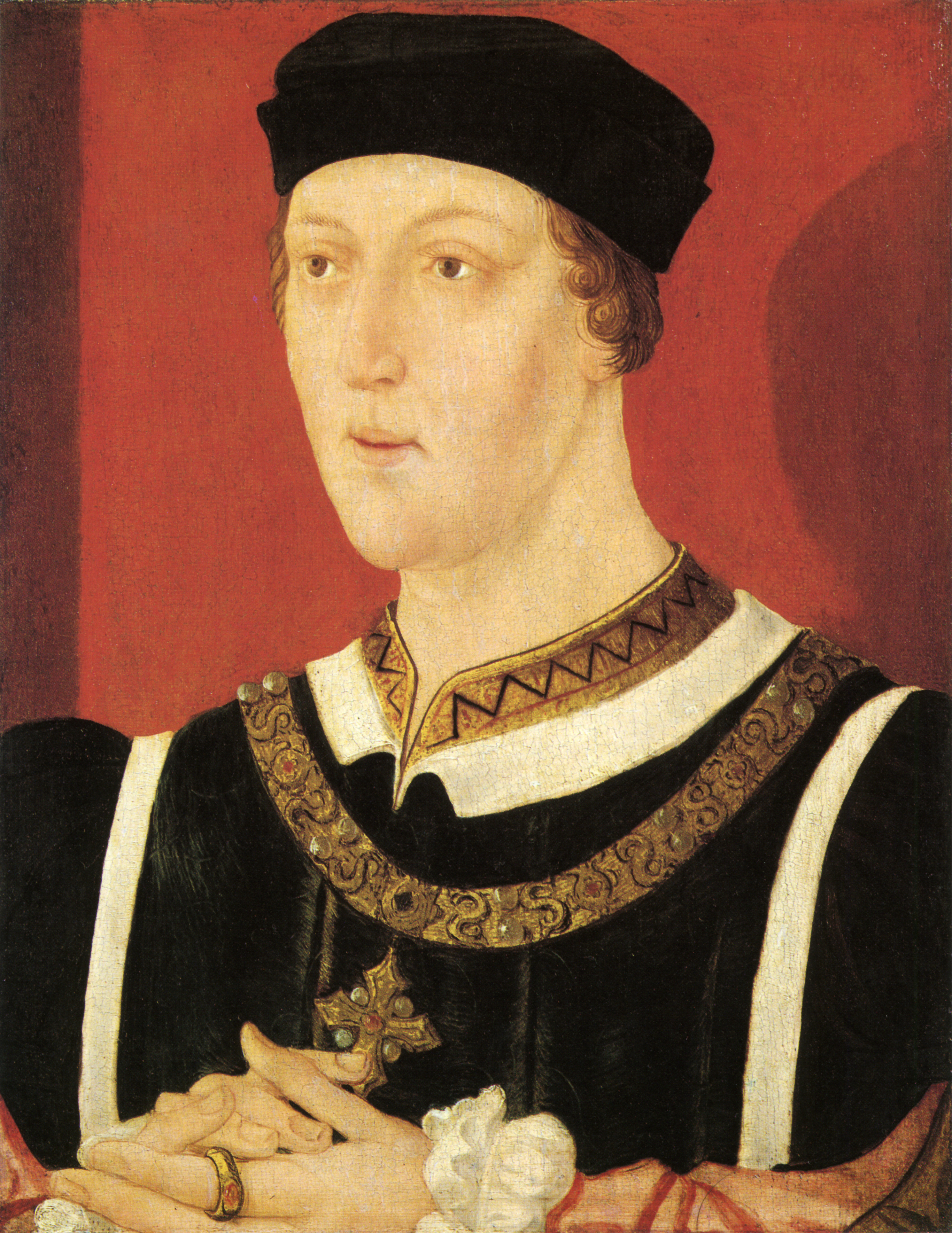 ,
,  , 6 December 1421
, 6 December 1421
Windsor Castle
Son of Henry V
and Catherine of Valois ,
Titchfield Abbey
22 April 1445
1 son , 21 May 1471
Tower of London
Allegedly murdered aged 49 , Son of Henry V
Agnatic primogeniture
4 March 1461
–
3 October 1470
''()'' ,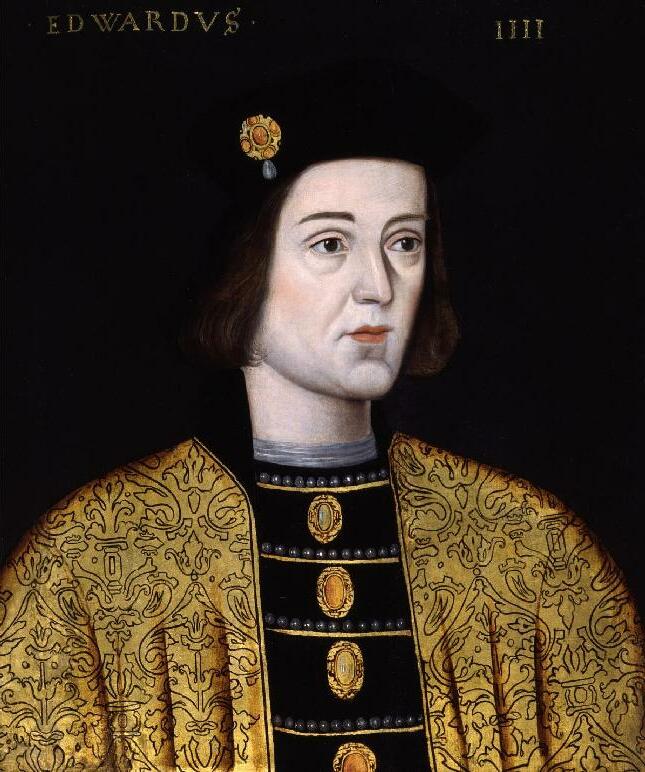 ,
,  , 28 April 1442
, 28 April 1442
Son of Richard of York
and Cecily Neville ,
Grafton Regis
1 May 1464
10 children , 9 April 1483
Westminster Palace
Aged 40 , Great-great-grandson heir general of
Seizure of the Crown
Henry VI
3 October 1470
–
11 April 1471
''()'' , ,
,  , 6 December 1421
, 6 December 1421
Windsor Castle
Son of Henry V
and Catherine of Valois ,
Titchfield Abbey
22 April 1445
1 son , 21 May 1471
Tower of London
Allegedly murdered aged 49 , Son of Henry V
Seizure of the Crown
11 April 1471
–
9 April 1483
''()'' , , rowspan=3 ,
, rowspan=3 ,  , 28 April 1442
, 28 April 1442
Son of Richard of York
and Cecily Neville ,
Grafton Regis
1 May 1464
10 children , 9 April 1483
Westminster Palace
Aged 40 , Great-great-grandson heir general of
Seizure of the Crown
9 April 1483
–
25 June 1483
''()'' ,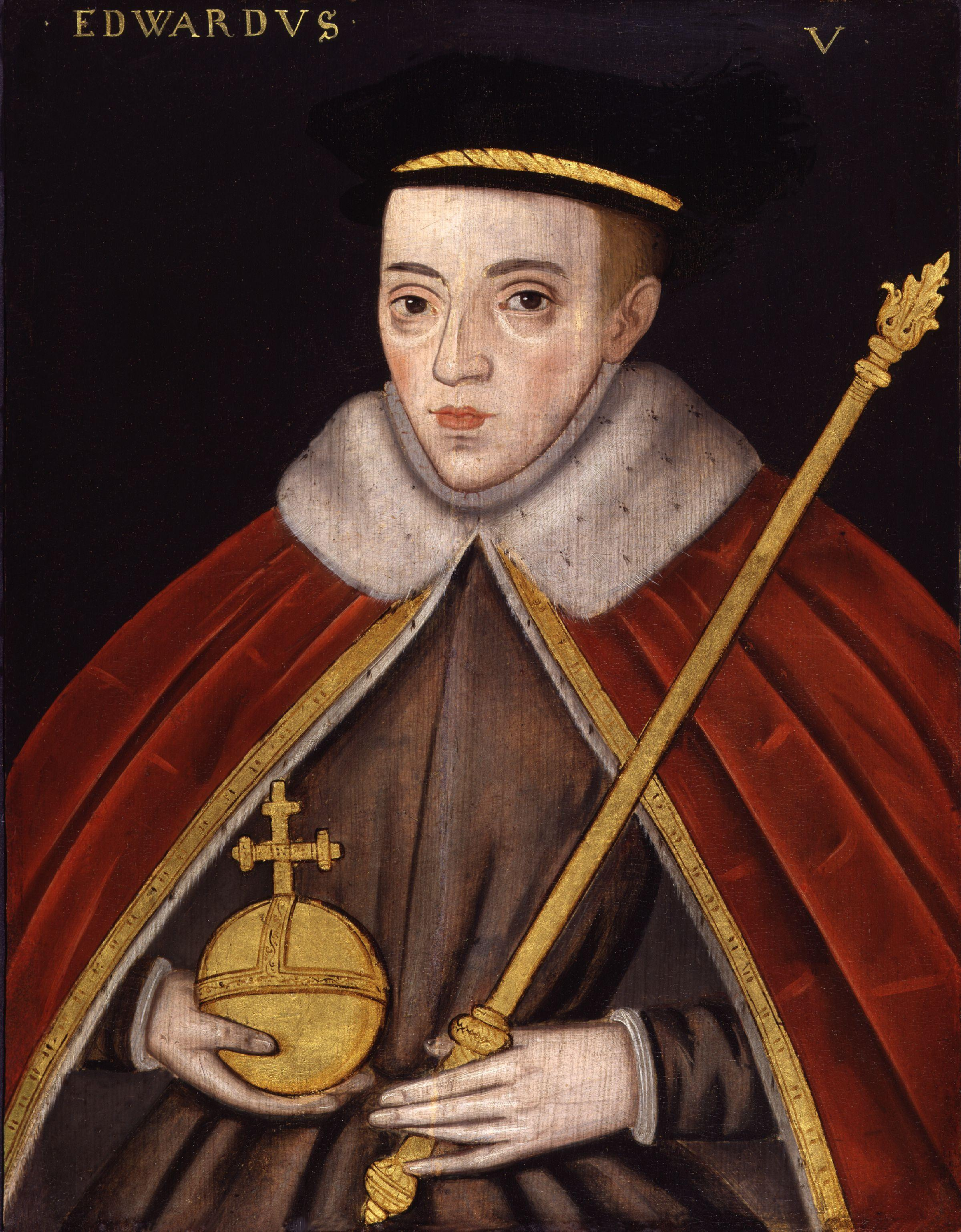 , 2 November 1470
, 2 November 1470
Westminster
Son of
and
London
Allegedly murdered aged 12 , Son of
Primogeniture , - ,
26 June 1483
–
22 August 1485
''()'' , , 2 October 1452
, 2 October 1452
Fotheringhay Castle
Son of Richard of York
and Cecily Neville , Anne Neville
Westminster Abbey
12 July 1472
1 son , 22 August 1485
Killed in battle aged 32 , Great-great-grandson of Edward III
'' Titulus Regius''
22 August 1485
–
21 April 1509
''()'' , , rowspan=3 ,
, rowspan=3 ,  , 28 January 1457
, 28 January 1457
Pembroke Castle
Son of Edmund Tudor
and Margaret Beaufort , Elizabeth of York
Westminster Abbey
18 January 1486
8 children , 21 April 1509
Richmond Palace
Aged 52 , Great-great-great-grandson of
Right of conquest
Marriage to Elizabeth of York , - ,
22 April 1509
–
28 January 1547
''()'' , , 28 June 1491
Greenwich Palace
Son of Henry VII
and Elizabeth of York ,
Greenwich
11 June 1509
1 daughter
Anne Boleyn
Westminster Palace
25 January 1533
1 daughter
Jane Seymour
Whitehall Palace
30 May 1536
1 son
''3 further marriages''
''No more children'' , 28 January 1547
Whitehall Palace
Aged 55 , Son of Henry VII
28 January 1547
–
6 July 1553
''()'' , , 12 October 1537
, 12 October 1537
Son of
and Jane Seymour , Unmarried , 6 July 1553
Greenwich Palace
Aged 15 , Son of
Primogeniture , - , Mary I
Bloody Mary
19 July 1553
–
17 November 1558
''()'' , , rowspan=2 ,
, rowspan=2 ,  , 18 February 1516
, 18 February 1516
Greenwich Palace
Daughter of
and
Winchester Cathedral
25 July 1554
No children , 17 November 1558
Aged 42 , Daughter of
Third Succession Act , - , ''(
Philip the Prudent
25 July 1554
–
17 November 1558
''()'' , , 21 May 1527
Valladolid
Son of Charles V of the Holy Roman Empire
and
Winchester Cathedral
25 July 1554
No children
''3 other marriages
7 children'' , 13 September 1598
El Escorial
Aged 71 , Husband of Mary I
Act for the Marriage of Queen Mary to Philip of Spain , - , colspan=99 align=left , Under the terms of the marriage treaty between Philip I of Naples (later Philip II of Spain from 15 January 1556) and Queen Mary I, Philip was to enjoy Mary's titles and honours for as long as their marriage should last. All official documents, including Acts of Parliament, were to be dated with both their names, and Parliament was to be called under the joint authority of the couple. An Act of Parliament gave him the title of king and stated that he "shall aid her Highness ... in the happy administration of her Grace's realms and dominions" (although elsewhere the Act stated that Mary was to be "sole queen"). Nonetheless, Philip was to co-reign with his wife. , - , Elizabeth I
The Virgin Queen
17 November 1558
–
24 March 1603
''()''
, ,
,  , 7 September 1533
, 7 September 1533
Greenwich Palace
Daughter of
and Anne Boleyn , Unmarried , 24 March 1603
Richmond Palace
Aged 69 , Daughter of
Third Succession Act
24 March 1603
–
27 March 1625
''()'' , , rowspan=2 ,
, rowspan=2 ,  , 19 June 1566
, 19 June 1566
Son of Mary, Queen of Scots, and Henry Stuart, Lord Darnley , Anne of Denmark
Oslo
23 November 1589
7 children , 27 March 1625
Theobalds House
Aged 58 , Great-great-grandson heir general of Henry VII , - , Charles I
27 March 1625
–
30 January 1649
''()'' , , 19 November 1600
, 19 November 1600
Dunfermline Palace
Son of James I
and Anne of Denmark , Henrietta Maria of France
13 June 1625
9 children , 30 January 1649
Whitehall Palace
Executed aged 48 , Son of James I
Cognatic primogeniture
16 December 1653
–
3 September 1658
''()'' , , rowspan=2 ,
, rowspan=2 ,  , 25 April 1599
, 25 April 1599
Huntingdon
Son of
and
St Giles
22 August 1620
9 children , 3 September 1658
Whitehall
Aged 59 , - , Richard Cromwell
3 September 1658
–
7 May 1659
''()'' ,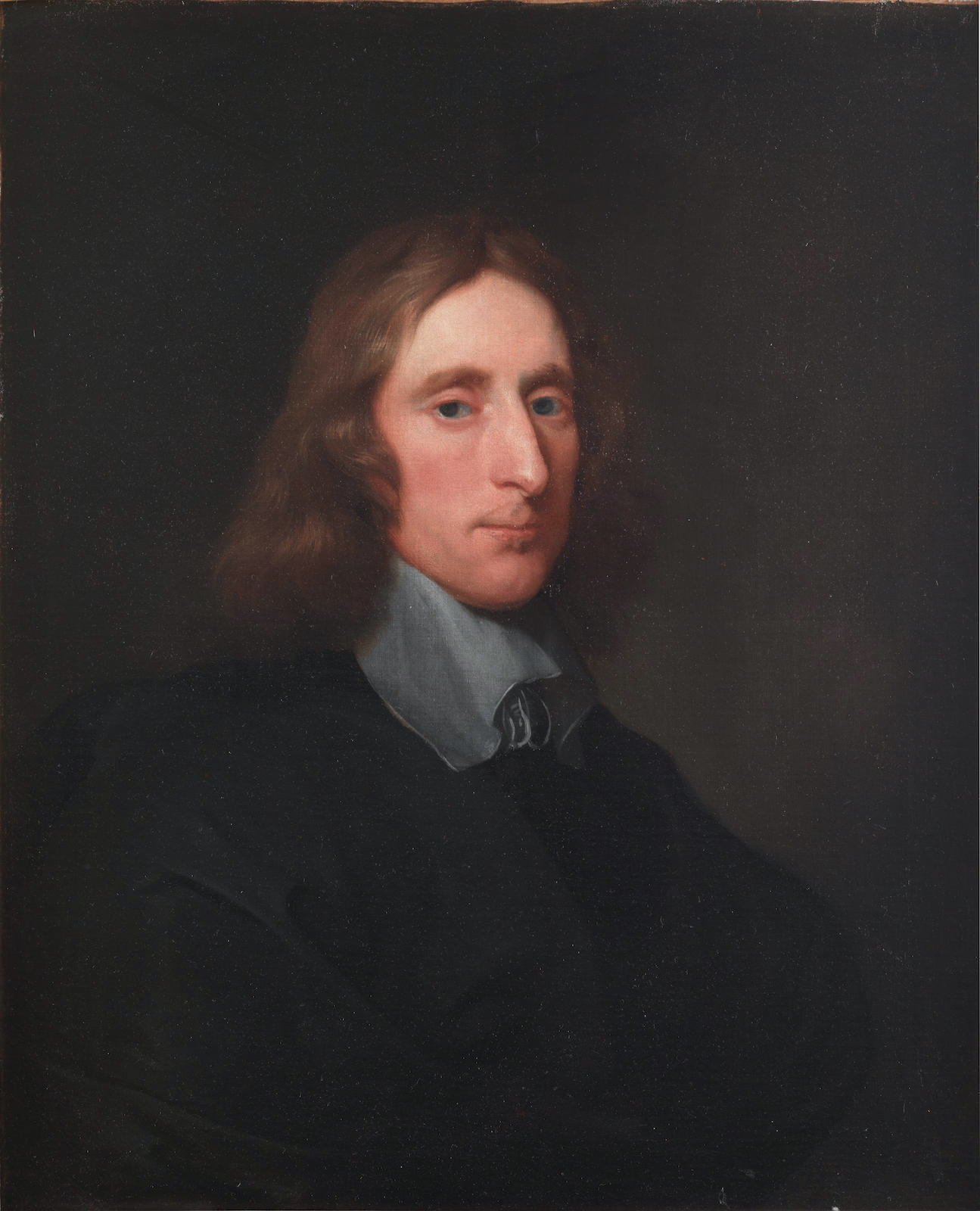 , 4 October 1626
, 4 October 1626
Huntingdon
Son of Oliver Cromwell
and Elizabeth Bourchier ,
May 1649
9 children , 12 July 1712
Cheshunt
Aged 85 Richard Cromwell was forcibly removed by the English Committee of Safety in May 1659. England again lacked any single head of state. After almost a year of anarchy, the monarchy was formally restored when Charles II returned from France to accept the throne.
29 May 1660
–
6 February 1685
''()'' ,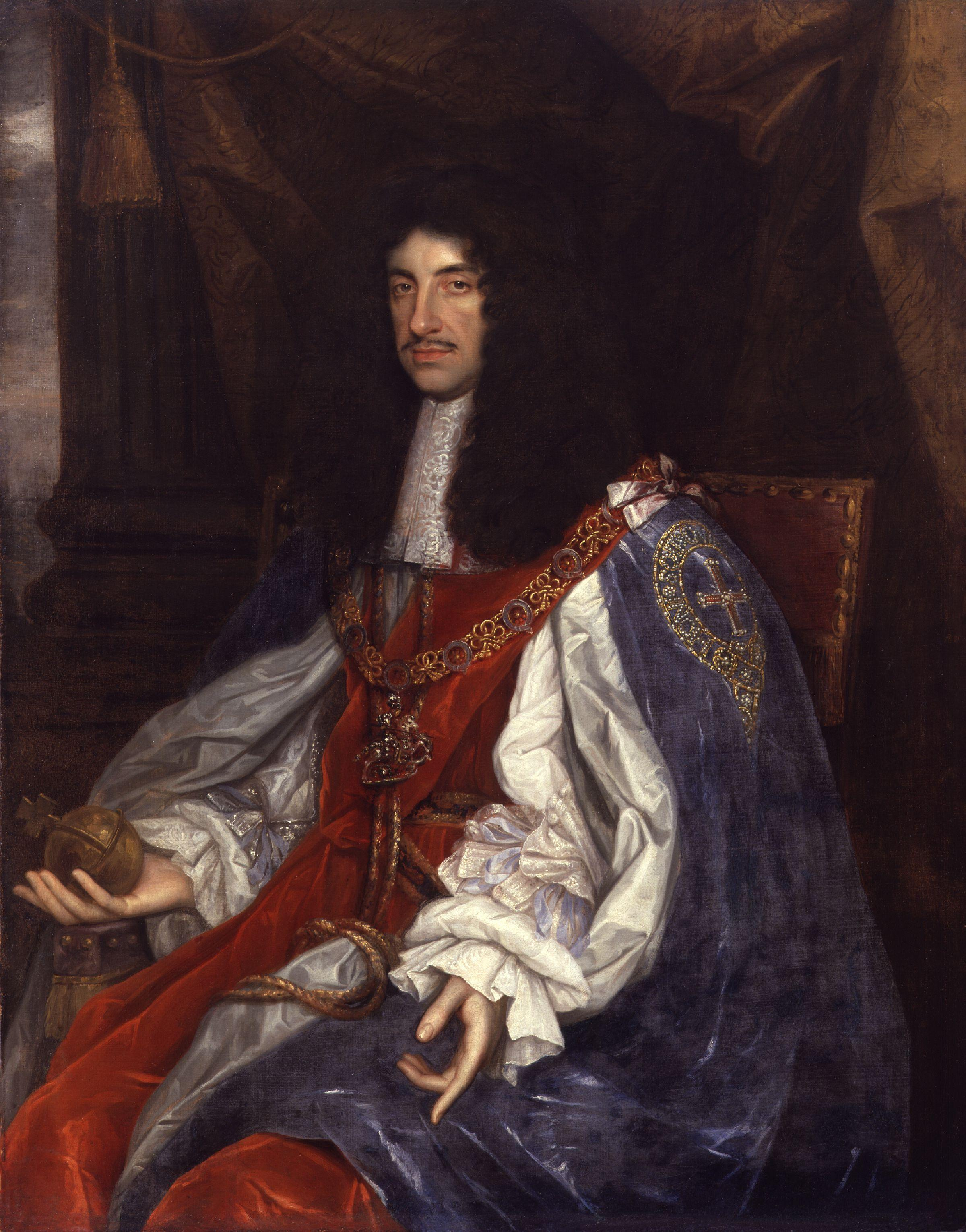 , rowspan=2 ,
, rowspan=2 ,  , 29 May 1630
, 29 May 1630
Son of Charles I
and Henrietta Maria of France , Catherine of Braganza
Portsmouth
21 May 1662
No children , 6 February 1685
Whitehall Palace
Aged 54 , Son of Charles I
Cognatic primogeniture
English Restoration , - ,
6 February 1685
–
23 December 1688
''( Overthrown after )'' , , 14 October 1633
, 14 October 1633
St James's Palace
Son of Charles I
and Henrietta Maria of France , Anne Hyde
The Strand
3 September 1660
8 children
21 November 1673
7 children , 16 September 1701
Aged 67 , Son of Charles I
Cognatic primogeniture
13 February 1689
–
28 December 1694
''()'' ,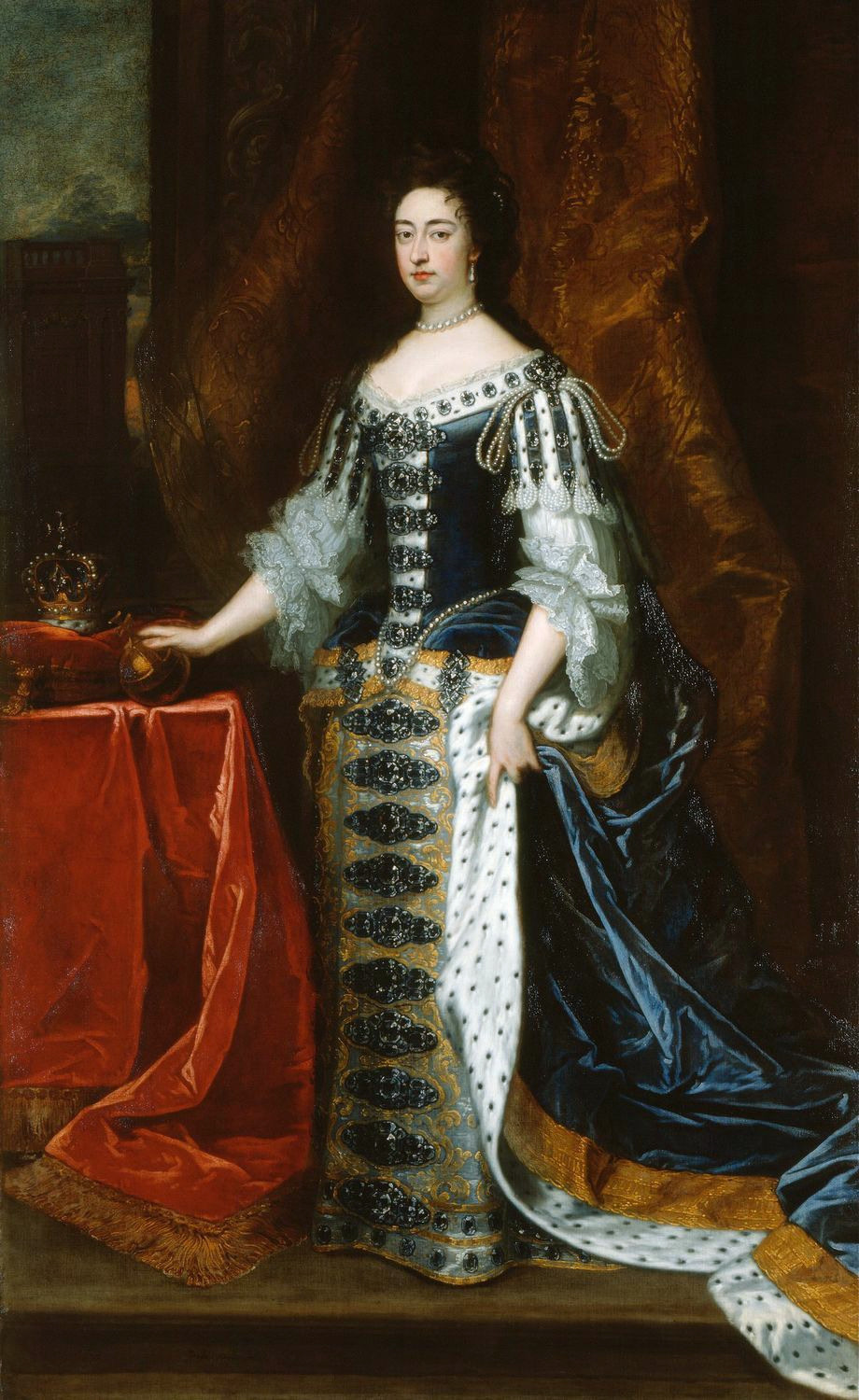 ,
,  , 30 April 1662
, 30 April 1662
St James's Palace
Daughter of
and Anne Hyde , William III of England
St James's Palace
4 November 1677
No children , 28 December 1694
Kensington Palace
Aged 32 , Daughter of
Offered the Crown by Parliament , - ,
William of Orange
13 February 1689
–
8 March 1702
''()'' , ,
,  , 4 November 1650
, 4 November 1650
The Hague
Son of William II of Orange
and Mary of England ,
4 November 1677
No children , 8 March 1702
Aged 51 , Grandson of Charles I
Offered the Crown by Parliament , - , Anne
8 March 1702
–
1 May 1707
''()''
' ,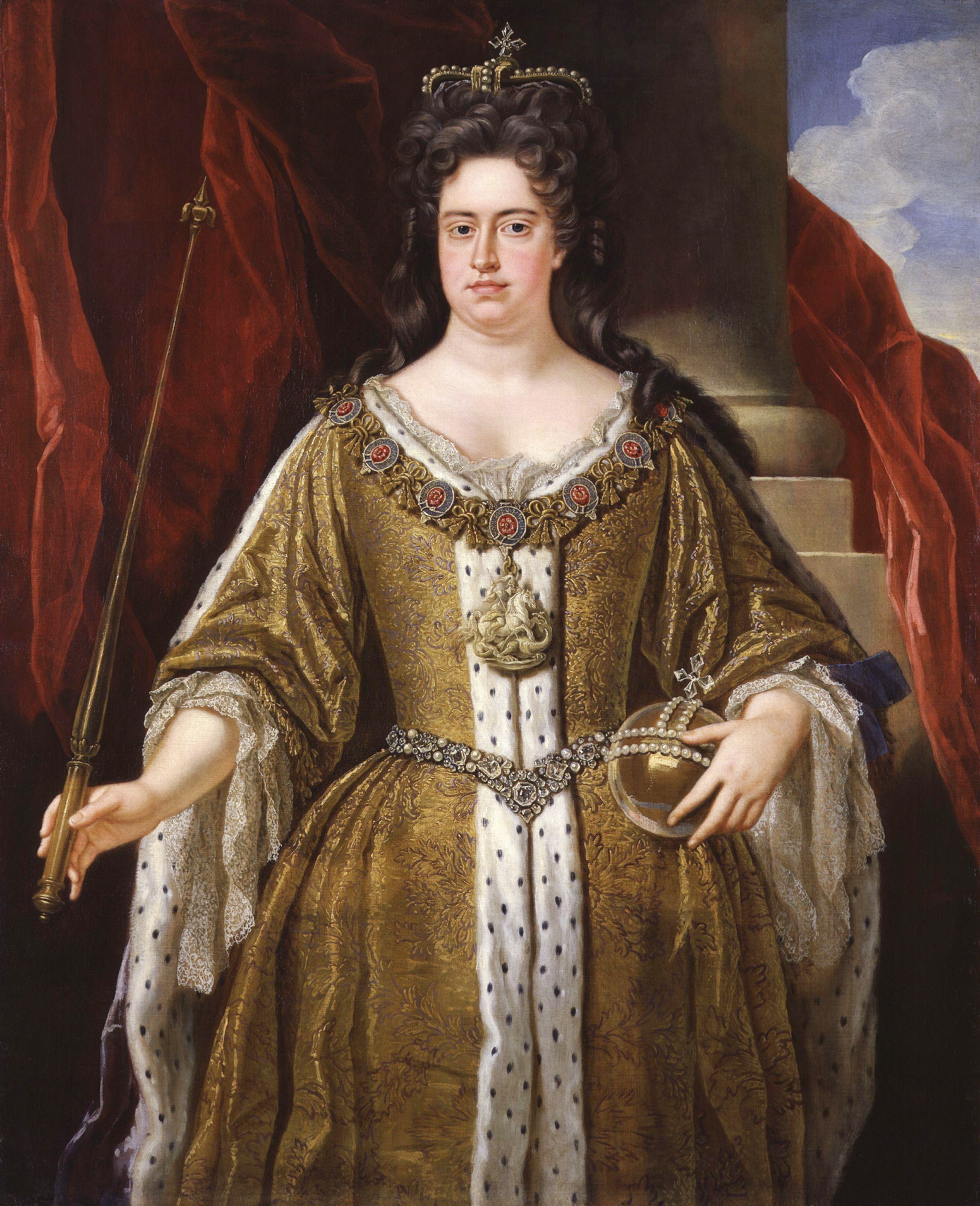 ,
,  , 6 February 1665
, 6 February 1665
St James's Palace
Daughter of James II
and Anne Hyde , George of Denmark
St James's Palace
28 July 1683
3 children , 1 August 1714
Kensington Palace
Aged 49 , Daughter of James II
Cognatic primogeniture
Bill of Rights 1689 While James and his descendants continued to claim the throne, all Catholics (such as James and his son
Alfred the Great
Alfred the Great (alt. Ælfred 848/849 – 26 October 899) was King of the West Saxons from 871 to 886, and King of the Anglo-Saxons from 886 until his death in 899. He was the youngest son of King Æthelwulf and his first wife Osburh, who bot ...
, who initially ruled Wessex, one of the seven Anglo-Saxon kingdoms which later made up modern England. Alfred styled himself King of the Anglo-Saxons from about 886, and while he was not the first king to claim to rule all of the English, his rule represents the start of the first unbroken line of kings to rule the whole of England, the House of Wessex.
Arguments are made for a few different kings thought to have controlled enough Anglo-Saxon kingdoms to be deemed the first king of England. For example, Offa of Mercia
Offa (died 29 July 796 AD) was List of monarchs of Mercia, King of Mercia, a kingdom of History of Anglo-Saxon England, Anglo-Saxon England, from 757 until his death. The son of Thingfrith and a descendant of Eowa of Mercia, Eowa, Offa came to ...
and Egbert of Wessex are sometimes described as kings of England by popular writers, but it is no longer the majority view of historians that their wide dominions are part of a process leading to a unified England. Historian Simon Keynes states, for example, that "Offa was driven by a lust for power, not a vision of English unity; and what he left was a reputation, not a legacy." This refers to a period in the late 8th century when Offa achieved a dominance over many of the kingdoms of southern England, but this did not survive his death in 796. Likewise, in 829 Egbert of Wessex conquered Mercia, but he soon lost control of it.
It was not until the late 9th century that one kingdom, Wessex, had become the dominant Anglo-Saxon kingdom. Its king, Alfred the Great, was overlord of western Mercia and used the title ''King of the Angles and Saxons'', but he never ruled eastern and northern England, which was then known as the Danelaw, having earlier been conquered by the Danes
Danes ( da, danskere, ) are a North Germanic ethnic group and nationality native to Denmark and a modern nation identified with the country of Denmark. This connection may be ancestral, legal, historical, or cultural.
Danes generally regard t ...
from southern Scandinavia. His son Edward the Elder conquered the eastern Danelaw, but Edward's son Æthelstan became the first king to rule the whole of England when he conquered Northumbria in 927, and he is regarded by some modern historians as the first true king of England. The title "King of the English" or in Latin, was first used to describe Æthelstan in one of his charters in 928. The standard title for monarchs from Æthelstan until John was "King of the English". Cnut the Great, a Dane, was the first to call himself "King of England". In the Norman period "King of the English" remained standard, with occasional use of "King of England" or . From John's reign onwards all other titles were eschewed in favour of "King" or "Queen of England".
The Principality of Wales was incorporated into the Kingdom of England under the Statute of Rhuddlan in 1284, and in 1301 King Edward I invested his eldest son, the future King Edward II, as Prince of Wales. Since that time, the eldest sons of all English monarchs, except for King Edward III, have borne this title.
After the death of Queen Elizabeth I without issue in 1603, King James VI of Scotland inherited the English crown as James I of England, joining the crowns of England and Scotland in personal union. By royal proclamation, James styled himself "King of Great Britain", but no such kingdom was actually created until 1707, when England and Scotland united during the reign of Queen Anne to form the new Kingdom of Great Britain, with a single British parliament sitting at Westminster. This marked the end of the Kingdom of England as a sovereign state.
House of Wessex
, - , AlfredAlfred the Great
c. 886
–
26 October 899
''(13 years)'' ,
 , 849
, 849Son of
Æthelwulf of Wessex C3, C-3, C.3, C03, C.III or C-III may refer to:
Life and biology
* C3 carbon fixation in plants
* C3-convertase, an enzyme
* Complement component 3, a protein of the innate immune system
* Apolipoprotein C3, a human very low density lipoprotein ...
and Osburh , Ealhswith of Gainsborough
868
5 children , 26 October 899
Aged about 50 , Son of
Æthelwulf of Wessex C3, C-3, C.3, C03, C.III or C-III may refer to:
Life and biology
* C3 carbon fixation in plants
* C3-convertase, an enzyme
* Complement component 3, a protein of the innate immune system
* Apolipoprotein C3, a human very low density lipoprotein ...
Treaty of Wedmore , - , Edward the Elder
26 October 899
–
17 July 924
''()'' ,
 ,
, Son of Alfred
and Ealhswith ,
Ecgwynn
Ecgwynn or Ecgwynna (Old English ''Eċġwynn'', lit. "sword joy"; ''fl''. 890s), was the first consort of Edward the Elder, later King of the English (reigned 899–924), by whom she bore the future King Æthelstan (r. 924–939), and a daughter ...
2 children
Ælfflæd Ælfflæd is a name of Anglo-Saxon England meaning Ælf (Elf) and flæd (beauty). It may refer to:
* Saint Ælfflæd of Whitby (654–714)
* Ælfflæd of Mercia, daughter of Offa, wife of King Æthelred I of Northumbria
* Ælfflæd, wife of Edwar ...
8 children
Eadgifu of Kent
4 children , 17 July 924
Aged about 50 , Son of Alfred , - , Æthelstan
Æthelstan the Glorious
924
–
27 October 939
''(14–15 years)'' ,
 , 894
, 894Son of Edward the Elder
and
Ecgwynn
Ecgwynn or Ecgwynna (Old English ''Eċġwynn'', lit. "sword joy"; ''fl''. 890s), was the first consort of Edward the Elder, later King of the English (reigned 899–924), by whom she bore the future King Æthelstan (r. 924–939), and a daughter ...
, Unmarried
, 27 October 939Aged about 45 , Son of Edward the Elder , - ,
Edmund I
Edmund I or Eadmund I (920/921 – 26 May 946) was King of the English from 27 October 939 until his death in 946. He was the elder son of King Edward the Elder and his third wife, Queen Eadgifu, and a grandson of King Alfred the Great. After ...
Edmund the Magnificent
27 October 939
–
26 May 946
''()'' ,
 ,
, Son of Edward the Elder
and Eadgifu of Kent ,
Ælfgifu of Shaftesbury
Ælfgifu of Shaftesbury (died 944) was the first wife of King Edmund I (r. 939–946). She was Queen of the English from her marriage in around 939 until her death in 944. Ælfgifu and Edmund were the parents of two future English kings, Eadwi ...
2 sons
Æthelflæd of Damerham
944
No children , 26 May 946
Pucklechurch
Killed in a brawl aged about 25 , Son of Edward the Elder , - , Eadred
26 May 946
–
23 November 955
''()'' ,
 ,
, Son of Edward the Elder
and Eadgifu of Kent , Unmarried , 23 November 955
Frome
Aged about 32 , Son of Edward the Elder , - , Eadwig
Eadwig All-Fair
23 November 955
–
1 October 959
''()'' ,
 ,
, Son of
Edmund I
Edmund I or Eadmund I (920/921 – 26 May 946) was King of the English from 27 October 939 until his death in 946. He was the elder son of King Edward the Elder and his third wife, Queen Eadgifu, and a grandson of King Alfred the Great. After ...
and
Ælfgifu of Shaftesbury
Ælfgifu of Shaftesbury (died 944) was the first wife of King Edmund I (r. 939–946). She was Queen of the English from her marriage in around 939 until her death in 944. Ælfgifu and Edmund were the parents of two future English kings, Eadwi ...
, ÆlfgifuNo verified children , 1 October 959
Aged about 19 , Son of
Edmund I
Edmund I or Eadmund I (920/921 – 26 May 946) was King of the English from 27 October 939 until his death in 946. He was the elder son of King Edward the Elder and his third wife, Queen Eadgifu, and a grandson of King Alfred the Great. After ...
, -
, Edgar the Peaceful1 October 959
–
8 July 975
''()'' ,
 ,
, Wessex
Son of Edmund I
and Ælfgifu of Shaftesbury , Æthelflæd
1 son
Ælfthryth
2 sons , 8 July 975
Winchester
Winchester is a City status in the United Kingdom, cathedral city in Hampshire, England. The city lies at the heart of the wider City of Winchester, a local government Districts of England, district, at the western end of the South Downs Nation ...
Aged 31 , Son of Edmund I , - , Edward the Martyr
8 July 975
–
18 March 978
''()'' ,
 ,
, Son of Edgar the Peaceful
and Æthelflæd , Unmarried , 18 March 978
Corfe Castle
Murdered aged about 16 , Son of Edgar the Peaceful , - , ''(1st reign)''
Æthelred the Unready
18 March 978
–
1013
''(34–35 years)'' ,
 ,
, Son of Edgar the Peaceful
and Ælfthryth , Ælfgifu of York
991
9 children
Emma of Normandy
1002
3 children , 23 April 1016
London
Aged about 48 , Son of Edgar the Peaceful
House of Denmark
England came under the control of Sweyn Forkbeard, a Danish king, after an invasion in 1013, during which Æthelred abandoned the throne and went into exile in Normandy. , - , SweynSweyn Forkbeard
25 December 1013
–
3 February 1014
''()'' ,
 , 17 April 963
, 17 April 963Denmark
Son of Harald Bluetooth
and either Tove or Gunhild , Gunhild of Wenden
7 children
Sigrid the Haughty
1 daughter , 3 February 1014
Gainsborough
Aged 50 , Right of conquest
House of Wessex (restored, first time)
Following the death of Sweyn Forkbeard, Æthelred the Unready returned fromexile
Exile is primarily penal expulsion from one's native country, and secondarily expatriation or prolonged absence from one's homeland under either the compulsion of circumstance or the rigors of some high purpose. Usually persons and peoples suf ...
and was again proclaimed king on 3 February 1014. His son succeeded him after being chosen king by the citizens of London and a part of the Witan, despite ongoing Danish efforts to wrest the crown from the West Saxons.
, -
, ''(2nd reign)''Æthelred the Unready
3 February 1014
–
23 April 1016
''()'' ,
 ,
, Son of Edgar the Peaceful
and Ælfthryth , Ælfgifu of York
991
9 children
Emma of Normandy
1002
3 children , 23 April 1016
London
Aged about 48 , Son of Edgar the Peaceful , - , Edmund Ironside
23 April 1016
–
30 November 1016
''()'' ,
 ,
, Son of Æthelred
and Ælfgifu of York , Edith of East Anglia
2 children , 30 November 1016
Glastonbury
Aged 26 , Son of Æthelred
House of Denmark (restored)
Following the decisive Battle of Assandun on 18 October 1016, King Edmund signed a treaty with Cnut (Canute) under which all of England except for Wessex would be controlled by Cnut. Upon Edmund's death just over a month later on 30 November, Cnut ruled the whole kingdom as its sole king for nineteen years. , CnutCnut the Great
18 October 1016
–
12 November 1035
''()'' ,
 ,
, Son of
Sweyn Forkbeard
Sweyn Forkbeard ( non, Sveinn Haraldsson tjúguskegg ; da, Svend Tveskæg; 17 April 963 – 3 February 1014) was King of Denmark from 986 to 1014, also at times King of the English and King of Norway. He was the father of King Harald II of D ...
and Gunhilda of Poland , Ælfgifu of Northampton
2 sons
Emma of Normandy
1017
2 children , 12 November 1035
Shaftesbury
Aged about 40 , Son of Sweyn
Treaty of Deerhurst , - , Harold Harefoot
12 November 1035
–
17 March 1040
''()'' ,
 ,
, Son of Cnut the Great
and Ælfgifu of Northampton , , 17 March 1040
Oxford
Aged about 24 , Son of Cnut the Great , - ,
Harthacnut
Harthacnut ( da, Hardeknud; "Tough-knot"; – 8 June 1042), traditionally Hardicanute, sometimes referred to as Canute III, was King of Denmark from 1035 to 1042 and King of the English from 1040 to 1042.
Harthacnut was the son of King ...
17 March 1040
–
8 June 1042
''()'' ,
 , 1018
, 1018Son of Cnut the Great
and Emma of Normandy , Unmarried , 8 June 1042
Lambeth
Lambeth () is a district in South London, England, in the London Borough of Lambeth, historically in the County of Surrey. It is situated south of Charing Cross. The population of the London Borough of Lambeth was 303,086 in 2011. The area expe ...
Aged about 24 , Son of Cnut the Great
House of Wessex (restored, second time)
AfterHarthacnut
Harthacnut ( da, Hardeknud; "Tough-knot"; – 8 June 1042), traditionally Hardicanute, sometimes referred to as Canute III, was King of Denmark from 1035 to 1042 and King of the English from 1040 to 1042.
Harthacnut was the son of King ...
, there was a Saxon Restoration between 1042 and 1066.
, -
, Edward the Confessor
Edward the Confessor ; la, Eduardus Confessor , ; ( 1003 – 5 January 1066) was one of the last Anglo-Saxon English kings. Usually considered the last king of the House of Wessex, he ruled from 1042 to 1066.
Edward was the son of Æth ...
8 June 1042
–
5 January 1066
''()'' ,
 ,
, Islip
Son of Æthelred
and Emma of Normandy , Edith of Wessex
23 January 1045
No children , 5 January 1066
Westminster Palace
Aged about 63 , Son of Æthelred
House of Godwin
, - , Harold IIHarold Godwinson
6 January 1066
–
14 October 1066
''()'' ,
 ,
, Son of
Godwin of Wessex
Godwin of Wessex ( ang, Godwine; – 15 April 1053) was an English nobleman who became one of the most powerful earls in Kingdom of England, England under the Denmark, Danish king Cnut the Great (King of England from 1016 to 1035) and his succ ...
and Gytha Thorkelsdóttir ,
Edith Swannesha
Edith the Fair ( ang, Ealdgȳð Swann hnesce, "Edyth the Gentle Swan"; c. 1025 – c. 1066), also known as Edith Swanneck,Her first name is also spelled Ealdgyth, Aldgyth, ''Edeva'' or Eddeva, and sometimes appears as ''Ēadgȳð'' and ''Ēadgif ...
5 children
Ealdgyth
2 sons , 14 October 1066
Hastings
Died in the Battle of Hastings aged 44 , Supposedly named heir by
Edward the Confessor
Edward the Confessor ; la, Eduardus Confessor , ; ( 1003 – 5 January 1066) was one of the last Anglo-Saxon English kings. Usually considered the last king of the House of Wessex, he ruled from 1042 to 1066.
Edward was the son of Æth ...
Elected by the Witenagemot
House of Normandy
In 1066, several rival claimants to the English throne emerged. Among them were Harold Godwinson (recognised as king by the Witenagemot after the death ofEdward the Confessor
Edward the Confessor ; la, Eduardus Confessor , ; ( 1003 – 5 January 1066) was one of the last Anglo-Saxon English kings. Usually considered the last king of the House of Wessex, he ruled from 1042 to 1066.
Edward was the son of Æth ...
), Harald Hardrada
Harald Sigurdsson (; – 25 September 1066), also known as Harald III of Norway and given the epithet ''Hardrada'' (; modern no, Hardråde, roughly translated as "stern counsel" or "hard ruler") in the sagas, was King of Norway from 1046 t ...
(King of Norway who claimed to be the rightful heir of Harthacnut) and Duke William II of Normandy (vassal to the King of France, and first cousin once-removed of Edward the Confessor). Harald and William both invaded separately in 1066. Godwinson successfully repelled the invasion by Hardrada, but ultimately lost the throne of England in the Norman conquest of England
The Norman Conquest (or the Conquest) was the 11th-century invasion and occupation of England by an army made up of thousands of Normans, Norman, Duchy of Brittany, Breton, County of Flanders, Flemish, and Kingdom of France, French troops, ...
.
After the Battle of Hastings on 14 October 1066, William the Conqueror made permanent the recent removal of the capital from Winchester
Winchester is a City status in the United Kingdom, cathedral city in Hampshire, England. The city lies at the heart of the wider City of Winchester, a local government Districts of England, district, at the western end of the South Downs Nation ...
to London. Following the death of Harold Godwinson at Hastings, the Anglo-Saxon Witenagemot elected as king Edgar Ætheling, the son of Edward the Exile and grandson of Edmund Ironside. The young monarch was unable to resist the invaders and was never crowned. William was crowned King William I of England on Christmas Day 1066, in Westminster Abbey, and is today known as William the Conqueror, William the Bastard or William I.
, -
, William IWilliam the Conqueror
25 December 1066
–
9 September 1087
''()'' ,
 ,
, Falaise Castle
Falaise may refer to:
Places
* Falaise, Ardennes, France
* Falaise, Calvados, France
** The Falaise pocket was the site of a battle in the Second World War
* La Falaise, in the Yvelines ''département'', France
* The Falaise escarpment in Quebe ...
Son of
Robert the Magnificent
Robert the Magnificent (french: le Magnifique;He was also, although erroneously, said to have been called 'Robert the Devil' (french: le Diable). Robert I was never known by the nickname 'the devil' in his lifetime. 'Robert the Devil' was a fic ...
and
Herleva
Herleva ( 1003 – c. 1050) was an 11th-century Norman woman known for having been mother of William the Conqueror, born to an extramarital relationship with Robert I, Duke of Normandy, and also of William's prominent half-brothers Odo of Bayeux ...
, Matilda of FlandersNormandy
1053
9 children , 9 September 1087
Rouen
Rouen (, ; or ) is a city on the River Seine in northern France. It is the prefecture of the Regions of France, region of Normandy (administrative region), Normandy and the Departments of France, department of Seine-Maritime. Formerly one of ...
Aged about 59 , Supposedly named heir in 1052 by
Edward the Confessor
Edward the Confessor ; la, Eduardus Confessor , ; ( 1003 – 5 January 1066) was one of the last Anglo-Saxon English kings. Usually considered the last king of the House of Wessex, he ruled from 1042 to 1066.
Edward was the son of Æth ...
First cousin once removed of Edward the Confessor
Right of conquest , - , William II
William Rufus
26 September 1087
–
2 August 1100
''()'' ,
 ,
, Normandy
Son of William the Conqueror
and Matilda of Flanders , Unmarried , 2 August 1100
New Forest
Shot with an arrow aged 44 , Son of William I
Granted the Kingdom of England over elder brother Robert Curthose , - , Henry I
Henry Beauclerc
5 August 1100
–
1 December 1135
''()'' ,
 , September 1068
, September 1068Selby
Son of William the Conqueror
and Matilda of Flanders , Matilda of Scotland
Westminster Abbey
11 November 1100
2 children
Adeliza of Louvain
Adeliza of Louvain, sometimes known in England as Adelicia of Louvain, also called Adela and Aleidis; (c. 1103 – March/April 1151) was Queen of England from 1121 to 1135, as the second wife of King Henry I. She was the daughter of Godfrey I, ...
Windsor Castle
29 January 1121
No children , 1 December 1135
Saint-Denis-en-Lyons
Aged 67 , Son of William I
Seizure of the Crown (from Robert Curthose)
House of Blois
Henry I left no legitimate male heirs, his son William Adelin having died in the '' White Ship'' disaster of 1120. This ended the direct Norman line of kings in England. Henry named his eldest daughter, Matilda (Countess of Anjou by her second marriage toGeoffrey Plantagenet, Count of Anjou
Geoffrey V (24 August 1113 – 7 September 1151), called the Handsome, the Fair (french: link=no, le Bel) or Plantagenet, was the count of Anjou, Count of Tours, Touraine and Count of Maine, Maine by inheritance from 1129, and also Duke of Nor ...
, as well as widow of her first husband, Henry V, Holy Roman Emperor
Henry V (german: Heinrich V.; probably 11 August 1081 or 1086 – 23 May 1125, in Utrecht) was King of Germany (from 1099 to 1125) and Holy Roman Emperor (from 1111 to 1125), as the fourth and last ruler of the Salian dynasty. He was made co-ru ...
), as his heir. Before naming Matilda as heir, he had been in negotiations to name his nephew Stephen of Blois as his heir. When Henry died, Stephen travelled to England, and in a coup d'etat had himself crowned instead of Matilda. The period which followed is known as The Anarchy
The Anarchy was a civil war in England and Normandy between 1138 and 1153, which resulted in a widespread breakdown in law and order. The conflict was a war of succession precipitated by the accidental death of William Adelin, the only legiti ...
, as parties supporting each side fought in open warfare both in Britain and on the continent for the better part of two decades.
, -
, StephenStephen of Blois
22 December 1135
–
25 October 1154
''()'' ,
 ,
, Blois
Son of Stephen II of Blois
and Adela of Normandy , Matilda of Boulogne
Westminster
1125
6 children , 25 October 1154
Dover Castle
Aged about 58 , Grandson of William I
Appointmentusurpation Count Eustace IV of Boulogne (c. 1130 – 17 August 1153) was appointed co-king of England by his father, King Stephen, on 6 April 1152, in order to guarantee his succession to the throne (as was the custom in France, but not in England). The Pope and the Church would not agree to this, and Eustace was not crowned. Eustace died the next year aged 23, during his father's lifetime, and so never became king in his own right.
House of Anjou/Plantagenet
King Stephen came to an agreement with Matilda in November 1153 with the signing of the Treaty of Wallingford, in which Stephen recognised Henry, son of Matilda and her second husbandGeoffrey Plantagenet, Count of Anjou
Geoffrey V (24 August 1113 – 7 September 1151), called the Handsome, the Fair (french: link=no, le Bel) or Plantagenet, was the count of Anjou, Count of Tours, Touraine and Count of Maine, Maine by inheritance from 1129, and also Duke of Nor ...
, as the designated heir. The royal house descended from Matilda and Geoffrey is widely known by two names, the House of Anjou
Angevin or House of Anjou may refer to:
* County of Anjou or Duchy of Anjou, a historical county, and later Duchy, in France
** Angevin (language), the traditional langue d'oïl spoken in Anjou
** Counts and Dukes of Anjou
*House of Ingelger, a Fra ...
(after Geoffrey's title as Count of Anjou) or the House of Plantagenet
The House of Plantagenet () was a royal house which originated from the lands of Anjou in France. The family held the English throne from 1154 (with the accession of Henry II at the end of the Anarchy) to 1485, when Richard III died in b ...
, after his sobriquet. Some historians prefer to group the subsequent kings into two groups, before and after the loss of the bulk of their French possessions, although they are not different royal houses.
The Angevins (from the French term meaning "from Anjou") ruled over the Angevin Empire during the 12th and 13th centuries, an area stretching from the Pyrenees to Ireland. They did not regard England as their primary home until most of their continental domains were lost by King John King John may refer to:
Rulers
* John, King of England (1166–1216)
* John I of Jerusalem (c. 1170–1237)
* John Balliol, King of Scotland (c. 1249–1314)
* John I of France (15–20 November 1316)
* John II of France (1319–1364)
* John I o ...
. The direct, eldest male line from Henry II includes monarchs commonly grouped together as the House of Plantagenet, which was the name given to the dynasty after the loss of most of their continental possessions, while cadet branches of this line became known as the House of Lancaster
The House of Lancaster was a cadet branch of the royal House of Plantagenet. The first house was created when King Henry III of England created the Earldom of Lancasterfrom which the house was namedfor his second son Edmund Crouchback in 126 ...
and the House of York
The House of York was a cadet branch of the English royal House of Plantagenet. Three of its members became kings of England in the late 15th century. The House of York descended in the male line from Edmund of Langley, 1st Duke of York, ...
during the War of the Roses.
The Angevins formulated England's royal coat of arms, which usually showed other kingdoms held or claimed by them or their successors, although without representation of Ireland for quite some time. '' Dieu et mon droit'' was first used as a battle cry
A battle cry or war cry is a yell or chant taken up in battle, usually by members of the same combatant group.
Battle cries are not necessarily articulate (e.g. "Eulaliaaaa!", "Alala"..), although they often aim to invoke patriotic or religious ...
by Richard I in 1198 at the Battle of Gisors
The Battle of Gisors (27 September 1198) was a skirmish fought in Courcelles-lès-Gisors, Oise, Picardy, part of the ongoing fighting between Richard I of England and Philip Augustus of France that lasted from 1194 to Richard's death in April 11 ...
, when he defeated the forces of Philip II of France. It has generally been used as the motto of English monarchs since being adopted by Edward III
Edward III (13 November 1312 – 21 June 1377), also known as Edward of Windsor before his accession, was King of England and Lord of Ireland from January 1327 until his death in 1377. He is noted for his military success and for restoring r ...
.
, -
, Henry IIHenry Curtmantle
19 December 1154
–
6 July 1189
''()'' ,
 ,
, Le Mans
Le Mans (, ) is a city in northwestern France on the Sarthe River where it meets the Huisne. Traditionally the capital of the province of Maine, it is now the capital of the Sarthe department and the seat of the Roman Catholic diocese of Le Man ...
Son of Geoffrey V of Anjou
and Matilda , Eleanor of Aquitaine
Bordeaux Cathedral
18 May 1152
8 children , 6 July 1189
Chinon
Aged 56 , Grandson of Henry I
Treaty of Wallingford , - , colspan=99 , Henry II named his son, Henry the Young King (1155–1183), as co-ruler with him but this was a Norman custom of designating an heir, and the younger Henry did not outlive his father and rule in his own right, so he is not counted as a monarch on lists of kings. , - , Richard I
Richard the Lionheart
3 September 1189
–
6 April 1199
''()'' ,
 , rowspan=2 ,
, rowspan=2 , Beaumont Palace
Son of Henry II
and Eleanor of Aquitaine , Berengaria of Navarre
Limassol
12 May 1191
No children , 6 April 1199
Châlus
Châlus (; oc, Chasluç) is a commune in the Haute-Vienne department in the Nouvelle-Aquitaine region in western France.
History
Richard I, King of England was besieging Châlus in 1199 when Pierre Basile wounded him with a crossbow bolt; ...
Shot by a
quarrel
Quarrel may refer to:
* A heated disagreement
* Crossbow bolt
A bolt or quarrel is a dart-like projectile used by crossbows. The name "quarrel" is derived from the French word ''carré'', meaning square, referring to their typically square ...
aged 41
, Son of Henry IIPrimogeniture
Primogeniture ( ) is the right, by law or custom, of the firstborn legitimate child to inherit the parent's entire or main estate in preference to shared inheritance among all or some children, any illegitimate child or any collateral relativ ...
, -
, JohnJohn Lackland
27 May 1199
–
19 October 1216
''()'' ,
 , 24 December 1166
, 24 December 1166Beaumont Palace
Son of Henry II
and Eleanor of Aquitaine , Isabel of Gloucester
Marlborough Castle
29 August 1189
No children
Isabella of Angoulême
Bordeaux Cathedral
24 August 1200
5 children , 19 October 1216
Newark-on-Trent
Aged 49 , Son of Henry II
Nomination
Proximity of blood
House of Plantagenet
The House of Plantagenet takes its name fromGeoffrey Plantagenet, Count of Anjou
Geoffrey V (24 August 1113 – 7 September 1151), called the Handsome, the Fair (french: link=no, le Bel) or Plantagenet, was the count of Anjou, Count of Tours, Touraine and Count of Maine, Maine by inheritance from 1129, and also Duke of Nor ...
, husband of Empress Matilda and father of Henry II. The name Plantagenet itself was unknown as a family name ''per se'' until Richard of York adopted it as his family name in the 15th century. It has since been retroactively applied to English monarchs from Henry II onward. It is common among modern historians to refer to Henry II and his sons as the "Angevins" due to their vast continental empire, and most of the Angevin kings before John spent more time in their continental possessions than in England.
It is from the time of Henry III, after the loss of most of the family's continental possessions, that the Plantagenet kings became more English in nature. The Houses of Lancaster and York are cadet branches of the House of Plantagenet.
, -
, Henry IIIHenry of Winchester
28 October 1216
–
16 November 1272
''()'' ,
 , rowspan=3 ,
, rowspan=3 , Winchester Castle
Son of John
and Isabella of Angoulême ,
Eleanor of Provence
Eleanor of Provence (c. 1223 – 24/25 June 1291) was a French noblewoman who became Queen of England as the wife of King Henry III from 1236 until his death in 1272. She served as regent of England during the absence of her spouse in 1253.
...
Canterbury Cathedral
Canterbury Cathedral in Canterbury, Kent, is one of the oldest and most famous Christian structures in England. It forms part of a World Heritage Site. It is the cathedral of the Archbishop of Canterbury, currently Justin Welby, leader of the ...
14 January 1236
5 children , 16 November 1272
Westminster Palace
Aged 65 , Son of John
Primogeniture , - ,
Edward I
Edward I (17/18 June 1239 – 7 July 1307), also known as Edward Longshanks and the Hammer of the Scots, was King of England and Lord of Ireland from 1272 to 1307. Concurrently, he ruled the duchies of Aquitaine and Gascony as a vassal o ...
Edward Longshanks
20 November 1272
–
7 July 1307
''()'' ,
 , 17 June 1239
, 17 June 1239Palace of Westminster
The Palace of Westminster serves as the meeting place for both the House of Commons of the United Kingdom, House of Commons and the House of Lords, the two houses of the Parliament of the United Kingdom. Informally known as the Houses of Parli ...
Son of Henry III
and
Eleanor of Provence
Eleanor of Provence (c. 1223 – 24/25 June 1291) was a French noblewoman who became Queen of England as the wife of King Henry III from 1236 until his death in 1272. She served as regent of England during the absence of her spouse in 1253.
...
, Eleanor of Castile
Eleanor of Castile (1241 – 28 November 1290) was Queen of England as the first wife of Edward I, whom she married as part of a political deal to affirm English sovereignty over Gascony.
The marriage was known to be particularly close, and ...
Abbey of Santa María la Real de Las Huelgas
The Abbey of Santa María la Real de Las Huelgas is a monastery of Cistercian nuns located approximately 1.5 km west of the city of Burgos in Spain. The word ''huelgas'', which usually refers to "labour strikes" in modern Spanish, refers i ...
18 October 1254
16 children
Margaret of France
Canterbury
10 September 1299
3 children , 7 July 1307
Burgh by Sands
Aged 68 , Son of Henry III
Primogeniture , - ,
Edward II
Edward II (25 April 1284 – 21 September 1327), also called Edward of Caernarfon, was King of England and Lord of Ireland from 1307 until he was deposed in January 1327. The fourth son of Edward I, Edward became the heir apparent to t ...
Edward of Caernarfon
8 July 1307
–
Abdicated 20 January 1327
''()'' ,
 , 25 April 1284
, 25 April 1284Caernarfon Castle
Caernarfon Castle ( cy, Castell Caernarfon ) – often anglicised as Carnarvon Castle or Caernarvon Castle – is a medieval fortress in Caernarfon, Gwynedd, north-west Wales cared for by Cadw, the Welsh Government's historic environ ...
Son of
Edward I
Edward I (17/18 June 1239 – 7 July 1307), also known as Edward Longshanks and the Hammer of the Scots, was King of England and Lord of Ireland from 1272 to 1307. Concurrently, he ruled the duchies of Aquitaine and Gascony as a vassal o ...
and
Eleanor of Castile
Eleanor of Castile (1241 – 28 November 1290) was Queen of England as the first wife of Edward I, whom she married as part of a political deal to affirm English sovereignty over Gascony.
The marriage was known to be particularly close, and ...
, Isabella of FranceBoulogne Cathedral
24 January 1308
4 children , 21 September 1327
Berkeley Castle
Murdered aged 43 , Son of
Edward I
Edward I (17/18 June 1239 – 7 July 1307), also known as Edward Longshanks and the Hammer of the Scots, was King of England and Lord of Ireland from 1272 to 1307. Concurrently, he ruled the duchies of Aquitaine and Gascony as a vassal o ...
Primogeniture , - ,
Edward III
Edward III (13 November 1312 – 21 June 1377), also known as Edward of Windsor before his accession, was King of England and Lord of Ireland from January 1327 until his death in 1377. He is noted for his military success and for restoring r ...
Edward of Windsor
25 January 1327
–
21 June 1377
''()'' ,
 ,
, , 13 November 1312
Windsor Castle
Son of
Edward II
Edward II (25 April 1284 – 21 September 1327), also called Edward of Caernarfon, was King of England and Lord of Ireland from 1307 until he was deposed in January 1327. The fourth son of Edward I, Edward became the heir apparent to t ...
and Isabella of France , Philippa of Hainault
York Minster
25 January 1328
14 children , 21 June 1377
Sheen Palace
Aged 64 , Son of
Edward II
Edward II (25 April 1284 – 21 September 1327), also called Edward of Caernarfon, was King of England and Lord of Ireland from 1307 until he was deposed in January 1327. The fourth son of Edward I, Edward became the heir apparent to t ...
Primogeniture , - ,
Richard II
Richard II (6 January 1367 – ), also known as Richard of Bordeaux, was King of England from 1377 until he was deposed in 1399. He was the son of Edward the Black Prince, Prince of Wales, and Joan, Countess of Kent. Richard's father died ...
Richard of Bordeaux
22 June 1377
–
29 September 1399
''()'' ,
 ,
, Bordeaux
Son of Edward the Black Prince
and Joan of Kent ,
Anne of Bohemia
Anne of Bohemia (11 May 1366 – 7 June 1394), also known as Anne of Luxembourg, was Queen of England as the first wife of King Richard II. A member of the House of Luxembourg, she was the eldest daughter of Charles IV, Holy Roman Emperor and ...
14 January 1382
No children
Isabella of Valois
Calais
Calais ( , , traditionally , ) is a port city in the Pas-de-Calais department, of which it is a subprefecture. Although Calais is by far the largest city in Pas-de-Calais, the department's prefecture is its third-largest city of Arras. Th ...
4 November 1396
No children , 14 February 1400
Pontefract Castle
Aged 33 , Grandson of
Edward III
Edward III (13 November 1312 – 21 June 1377), also known as Edward of Windsor before his accession, was King of England and Lord of Ireland from January 1327 until his death in 1377. He is noted for his military success and for restoring r ...
Primogeniture
House of Lancaster
This house descended from Edward III's third surviving son,John of Gaunt
John of Gaunt, Duke of Lancaster (6 March 1340 – 3 February 1399) was an English royal prince, military leader, and statesman. He was the fourth son (third to survive infancy as William of Hatfield died shortly after birth) of King Edward ...
. Henry IV seized power from Richard II (and also displaced the next in line to the throne, Edmund Mortimer (then aged 7), a descendant of Edward III's second son, Lionel of Antwerp).
, -
, Henry IVHenry of Bolingbroke
30 September 1399
–
20 March 1413
''()'' ,
 ,
, , April 1367
Bolingbroke Castle
Son of
John of Gaunt
John of Gaunt, Duke of Lancaster (6 March 1340 – 3 February 1399) was an English royal prince, military leader, and statesman. He was the fourth son (third to survive infancy as William of Hatfield died shortly after birth) of King Edward ...
and Blanche of Lancaster , Mary de Bohun
Arundel Castle
Arundel Castle is a restored and remodelled medieval castle in Arundel, West Sussex, England. It was established during the reign of Edward the Confessor and completed by Roger de Montgomery. The castle was damaged in the English Civil War a ...
27 July 1380
6 children
Joanna of Navarre
Winchester Cathedral
7 February 1403
No children , 20 March 1413
Westminster Abbey
Aged 45 , Grandson heir male of
Edward III
Edward III (13 November 1312 – 21 June 1377), also known as Edward of Windsor before his accession, was King of England and Lord of Ireland from January 1327 until his death in 1377. He is noted for his military success and for restoring r ...
Usurpation , - , Henry V
Henry of Monmouth
21 March 1413
–
31 August 1422
''()'' ,
Monmouth Castle
Son of Henry IV
and Mary de Bohun , Catherine of Valois
Troyes Cathedral
2 June 1420
1 son , 31 August 1422
Château de Vincennes
The Château de Vincennes () is a former fortress and royal residence next to the town of Vincennes, on the eastern edge of Paris, alongside the Bois de Vincennes. It was largely built between 1361 and 1369, and was a preferred residence, after ...
Aged 35 , Son of Henry IV
Agnatic primogeniture , - , ''(1st reign)''
Henry VI
1 September 1422
–
4 March 1461
''()'' ,
 ,
, Windsor Castle
Son of Henry V
and Catherine of Valois ,
Margaret of Anjou
Margaret of Anjou (french: link=no, Marguerite; 23 March 1430 – 25 August 1482) was Queen of England and nominally Queen of France by marriage to King Henry VI from 1445 to 1461 and again from 1470 to 1471. Born in the Duchy of Lorrain ...
Titchfield Abbey
22 April 1445
1 son , 21 May 1471
Tower of London
Allegedly murdered aged 49 , Son of Henry V
Agnatic primogeniture
House of York
The House of York claimed the right to the throne through Edward III's second surviving son, Lionel of Antwerp, but it inherited its name from Edward's fourth surviving son, Edmund of Langley, firstDuke of York
Duke of York is a title of nobility in the Peerage of the United Kingdom. Since the 15th century, it has, when granted, usually been given to the second son of English (later British) monarchs. The equivalent title in the Scottish peerage was Du ...
.
The Wars of the Roses (1455–1485) saw the throne pass back and forth between the rival houses of Lancaster and York.
, -
, ''(1st reign)''Edward IV
Edward IV (28 April 1442 – 9 April 1483) was King of England from 4 March 1461 to 3 October 1470, then again from 11 April 1471 until his death in 1483. He was a central figure in the Wars of the Roses, a series of civil wars in England ...
4 March 1461
–
3 October 1470
''()'' ,
 ,
, Rouen
Rouen (, ; or ) is a city on the River Seine in northern France. It is the prefecture of the Regions of France, region of Normandy (administrative region), Normandy and the Departments of France, department of Seine-Maritime. Formerly one of ...
Son of Richard of York
and Cecily Neville ,
Elizabeth Woodville
Elizabeth Woodville (also spelt Wydville, Wydeville, or Widvile;Although spelling of the family name is usually modernised to "Woodville", it was spelt "Wydeville" in contemporary publications by Caxton, but her tomb at St. George's Chapel, Wind ...
Grafton Regis
1 May 1464
10 children , 9 April 1483
Westminster Palace
Aged 40 , Great-great-grandson heir general of
Edward III
Edward III (13 November 1312 – 21 June 1377), also known as Edward of Windsor before his accession, was King of England and Lord of Ireland from January 1327 until his death in 1377. He is noted for his military success and for restoring r ...
Seizure of the Crown
Act of Accord
The Act of Accord was an Act of the Parliament of England which was passed on 25 October 1460, three weeks after Richard of York had entered the Council Chamber and laid his hand on the empty throne. Under the Act, King Henry VI of England was to ...
House of Lancaster (restored)
, - , ''( 2nd reign)''Henry VI
3 October 1470
–
11 April 1471
''()'' ,
 ,
, Windsor Castle
Son of Henry V
and Catherine of Valois ,
Margaret of Anjou
Margaret of Anjou (french: link=no, Marguerite; 23 March 1430 – 25 August 1482) was Queen of England and nominally Queen of France by marriage to King Henry VI from 1445 to 1461 and again from 1470 to 1471. Born in the Duchy of Lorrain ...
Titchfield Abbey
22 April 1445
1 son , 21 May 1471
Tower of London
Allegedly murdered aged 49 , Son of Henry V
Seizure of the Crown
House of York (restored)
, - , ''(2nd reign)''Edward IV
Edward IV (28 April 1442 – 9 April 1483) was King of England from 4 March 1461 to 3 October 1470, then again from 11 April 1471 until his death in 1483. He was a central figure in the Wars of the Roses, a series of civil wars in England ...
11 April 1471
–
9 April 1483
''()'' ,
 , rowspan=3 ,
, rowspan=3 , Rouen
Rouen (, ; or ) is a city on the River Seine in northern France. It is the prefecture of the Regions of France, region of Normandy (administrative region), Normandy and the Departments of France, department of Seine-Maritime. Formerly one of ...
Son of Richard of York
and Cecily Neville ,
Elizabeth Woodville
Elizabeth Woodville (also spelt Wydville, Wydeville, or Widvile;Although spelling of the family name is usually modernised to "Woodville", it was spelt "Wydeville" in contemporary publications by Caxton, but her tomb at St. George's Chapel, Wind ...
Grafton Regis
1 May 1464
10 children , 9 April 1483
Westminster Palace
Aged 40 , Great-great-grandson heir general of
Edward III
Edward III (13 November 1312 – 21 June 1377), also known as Edward of Windsor before his accession, was King of England and Lord of Ireland from January 1327 until his death in 1377. He is noted for his military success and for restoring r ...
Seizure of the Crown
Act of Accord
The Act of Accord was an Act of the Parliament of England which was passed on 25 October 1460, three weeks after Richard of York had entered the Council Chamber and laid his hand on the empty throne. Under the Act, King Henry VI of England was to ...
, -
, Edward V
Edward V (2 November 1470 – mid-1483)R. F. Walker, "Princes in the Tower", in S. H. Steinberg et al, ''A New Dictionary of British History'', St. Martin's Press, New York, 1963, p. 286. was ''de jure'' King of England and Lord of Ireland fro ...
9 April 1483
–
25 June 1483
''()'' ,
 , 2 November 1470
, 2 November 1470Westminster
Son of
Edward IV
Edward IV (28 April 1442 – 9 April 1483) was King of England from 4 March 1461 to 3 October 1470, then again from 11 April 1471 until his death in 1483. He was a central figure in the Wars of the Roses, a series of civil wars in England ...
and
Elizabeth Woodville
Elizabeth Woodville (also spelt Wydville, Wydeville, or Widvile;Although spelling of the family name is usually modernised to "Woodville", it was spelt "Wydeville" in contemporary publications by Caxton, but her tomb at St. George's Chapel, Wind ...
, Unmarried
, Disappeared mid-1483London
Allegedly murdered aged 12 , Son of
Edward IV
Edward IV (28 April 1442 – 9 April 1483) was King of England from 4 March 1461 to 3 October 1470, then again from 11 April 1471 until his death in 1483. He was a central figure in the Wars of the Roses, a series of civil wars in England ...
Primogeniture , - ,
Richard III
Richard III (2 October 145222 August 1485) was King of England and Lord of Ireland from 26 June 1483 until his death in 1485. He was the last king of the House of York and the last of the Plantagenet dynasty. His defeat and death at the Battl ...
26 June 1483
–
22 August 1485
''()'' ,
 , 2 October 1452
, 2 October 1452Fotheringhay Castle
Son of Richard of York
and Cecily Neville , Anne Neville
Westminster Abbey
12 July 1472
1 son , 22 August 1485
Bosworth Field
The Battle of Bosworth or Bosworth Field was the last significant battle of the Wars of the Roses, the civil war between the houses of Lancaster and York that extended across England in the latter half of the 15th century. Fought on 22 Augu ...
Killed in battle aged 32 , Great-great-grandson of Edward III
'' Titulus Regius''
House of Tudor
The Tudors descended in the female line from John Beaufort, one of the illegitimate children ofJohn of Gaunt
John of Gaunt, Duke of Lancaster (6 March 1340 – 3 February 1399) was an English royal prince, military leader, and statesman. He was the fourth son (third to survive infancy as William of Hatfield died shortly after birth) of King Edward ...
(third surviving son of Edward III), by Gaunt's long-term mistress Katherine Swynford
Katherine Swynford, Duchess of Lancaster (born Katherine de Roet, – 10 May 1403), also spelled Katharine or Catherine, was the third wife of John of Gaunt, Duke of Lancaster, the fourth (but third surviving) son of King Edward III.
Daughter o ...
. Those descended from English monarchs only through an illegitimate child would normally have no claim on the throne, but the situation was complicated when Gaunt and Swynford eventually married in 1396 (25 years after John Beaufort's birth). In view of the marriage, the church retroactively declared the Beauforts legitimate via a papal bull the same year.Michael K. Jones and Malcolm G. Underwood, ''The King's Mother: Lady Margaret Beaufort, Countess of Richmond and Derby'', (Cambridge University Press, 1995), 19–20. Parliament did the same in an Act in 1397. A subsequent proclamation by John of Gaunt's legitimate son, King Henry IV, also recognised the Beauforts' legitimacy, but declared them ineligible ever to inherit the throne. Nevertheless, the Beauforts remained closely allied with Gaunt's other descendants, the Royal House of Lancaster
The House of Lancaster was a cadet branch of the royal House of Plantagenet. The first house was created when King Henry III of England created the Earldom of Lancasterfrom which the house was namedfor his second son Edmund Crouchback in 126 ...
.
John Beaufort's granddaughter Lady Margaret Beaufort
Lady Margaret Beaufort (usually pronounced: or ; 31 May 1441/43 – 29 June 1509) was a major figure in the Wars of the Roses of the late fifteenth century, and mother of King Henry VII of England, the first Tudor monarch.
A descendant of ...
was married to Edmund Tudor. Tudor was the son of Welsh courtier Owain Tudur (anglicised to Owen Tudor) and Catherine of Valois, the widow of the Lancastrian King Henry V. Edmund Tudor and his siblings were either illegitimate, or the product of a secret marriage, and owed their fortunes to the goodwill of their legitimate half-brother King Henry VI
Henry VI (6 December 1421 – 21 May 1471) was King of England and Lord of Ireland from 1422 to 1461 and again from 1470 to 1471, and disputed King of France from 1422 to 1453. The only child of Henry V, he succeeded to the English throne a ...
. When the House of Lancaster fell from power, the Tudors followed.
By the late 15th century, the Tudors were the last hope for the Lancaster supporters. Edmund Tudor's son became king as Henry VII after defeating Richard III at the Battle of Bosworth Field
The Battle of Bosworth or Bosworth Field was the last significant battle of the Wars of the Roses, the civil war between the houses of Lancaster and York that extended across England in the latter half of the 15th century. Fought on 22 Augu ...
in 1485, winning the Wars of the Roses. King Henry married Elizabeth of York, daughter of Edward IV, thereby uniting the Lancastrian and York lineages. (See family tree.)
, -
, Henry VII22 August 1485
–
21 April 1509
''()'' ,
 , rowspan=3 ,
, rowspan=3 , Pembroke Castle
Son of Edmund Tudor
and Margaret Beaufort , Elizabeth of York
Westminster Abbey
18 January 1486
8 children , 21 April 1509
Richmond Palace
Aged 52 , Great-great-great-grandson of
Edward III
Edward III (13 November 1312 – 21 June 1377), also known as Edward of Windsor before his accession, was King of England and Lord of Ireland from January 1327 until his death in 1377. He is noted for his military success and for restoring r ...
Right of conquest
Marriage to Elizabeth of York , - ,
Henry VIII
Henry VIII (28 June 149128 January 1547) was King of England from 22 April 1509 until his death in 1547. Henry is best known for his six marriages, and for his efforts to have his first marriage (to Catherine of Aragon) annulled. His disa ...
22 April 1509
–
28 January 1547
''()'' , , 28 June 1491
Greenwich Palace
Son of Henry VII
and Elizabeth of York ,
Catherine of Aragon
Catherine of Aragon (also spelt as Katherine, ; 16 December 1485 – 7 January 1536) was Queen of England as the first wife of King Henry VIII from their marriage on 11 June 1509 until their annulment on 23 May 1533. She was previously ...
Greenwich
11 June 1509
1 daughter
Anne Boleyn
Westminster Palace
25 January 1533
1 daughter
Jane Seymour
Whitehall Palace
30 May 1536
1 son
''3 further marriages''
''No more children'' , 28 January 1547
Whitehall Palace
Aged 55 , Son of Henry VII
Primogeniture
Primogeniture ( ) is the right, by law or custom, of the firstborn legitimate child to inherit the parent's entire or main estate in preference to shared inheritance among all or some children, any illegitimate child or any collateral relativ ...
, -
, Edward VI28 January 1547
–
6 July 1553
''()'' ,
 , 12 October 1537
, 12 October 1537Hampton Court Palace
Hampton Court Palace is a Grade I listed royal palace in the London Borough of Richmond upon Thames, southwest and upstream of central London on the River Thames. The building of the palace began in 1514 for Cardinal Thomas Wolsey, the chie ...
Son of
Henry VIII
Henry VIII (28 June 149128 January 1547) was King of England from 22 April 1509 until his death in 1547. Henry is best known for his six marriages, and for his efforts to have his first marriage (to Catherine of Aragon) annulled. His disa ...
and Jane Seymour , Unmarried , 6 July 1553
Greenwich Palace
Aged 15 , Son of
Henry VIII
Henry VIII (28 June 149128 January 1547) was King of England from 22 April 1509 until his death in 1547. Henry is best known for his six marriages, and for his efforts to have his first marriage (to Catherine of Aragon) annulled. His disa ...
Primogeniture , - , Mary I
Bloody Mary
19 July 1553
–
17 November 1558
''()'' ,
 , rowspan=2 ,
, rowspan=2 , Greenwich Palace
Daughter of
Henry VIII
Henry VIII (28 June 149128 January 1547) was King of England from 22 April 1509 until his death in 1547. Henry is best known for his six marriages, and for his efforts to have his first marriage (to Catherine of Aragon) annulled. His disa ...
and
Catherine of Aragon
Catherine of Aragon (also spelt as Katherine, ; 16 December 1485 – 7 January 1536) was Queen of England as the first wife of King Henry VIII from their marriage on 11 June 1509 until their annulment on 23 May 1533. She was previously ...
, Philip II of Spain
Philip II) in Spain, while in Portugal and his Italian kingdoms he ruled as Philip I ( pt, Filipe I). (21 May 152713 September 1598), also known as Philip the Prudent ( es, Felipe el Prudente), was King of Spain from 1556, King of Portugal from ...
Winchester Cathedral
25 July 1554
No children , 17 November 1558
St James's Palace
St James's Palace is the most senior royal palace in London, the capital of the United Kingdom. The palace gives its name to the Court of St James's, which is the monarch's royal court, and is located in the City of Westminster in London. Altho ...
Aged 42 , Daughter of
Henry VIII
Henry VIII (28 June 149128 January 1547) was King of England from 22 April 1509 until his death in 1547. Henry is best known for his six marriages, and for his efforts to have his first marriage (to Catherine of Aragon) annulled. His disa ...
Third Succession Act , - , ''(
Jure uxoris
''Jure uxoris'' (a Latin phrase meaning "by right of (his) wife"), citing . describes a title of nobility used by a man because his wife holds the office or title ''suo jure'' ("in her own right"). Similarly, the husband of an heiress could becom ...
)''Philip
Philip, also Phillip, is a male given name, derived from the Greek (''Philippos'', lit. "horse-loving" or "fond of horses"), from a compound of (''philos'', "dear", "loved", "loving") and (''hippos'', "horse"). Prominent Philips who popularize ...
Philip the Prudent
25 July 1554
–
17 November 1558
''()'' , , 21 May 1527
Valladolid
Son of Charles V of the Holy Roman Empire
and
Isabella of Portugal
Isabella of Portugal (24 October 1503 – 1 May 1539) was the empress consort and queen consort of her cousin Charles V, Holy Roman Emperor, King of Spain, Archduke of Austria, and Duke of Burgundy. She was Queen of Spain and Germany, and La ...
, Mary I of England
Mary I (18 February 1516 – 17 November 1558), also known as Mary Tudor, and as "Bloody Mary" by her Protestant opponents, was Queen of England and Ireland from July 1553 and Queen of Spain from January 1556 until her death in 1558. Sh ...
Winchester Cathedral
25 July 1554
No children
''3 other marriages
7 children'' , 13 September 1598
El Escorial
Aged 71 , Husband of Mary I
Act for the Marriage of Queen Mary to Philip of Spain , - , colspan=99 align=left , Under the terms of the marriage treaty between Philip I of Naples (later Philip II of Spain from 15 January 1556) and Queen Mary I, Philip was to enjoy Mary's titles and honours for as long as their marriage should last. All official documents, including Acts of Parliament, were to be dated with both their names, and Parliament was to be called under the joint authority of the couple. An Act of Parliament gave him the title of king and stated that he "shall aid her Highness ... in the happy administration of her Grace's realms and dominions" (although elsewhere the Act stated that Mary was to be "sole queen"). Nonetheless, Philip was to co-reign with his wife. , - , Elizabeth I
The Virgin Queen
17 November 1558
–
24 March 1603
''()''
,
 ,
, Greenwich Palace
Daughter of
Henry VIII
Henry VIII (28 June 149128 January 1547) was King of England from 22 April 1509 until his death in 1547. Henry is best known for his six marriages, and for his efforts to have his first marriage (to Catherine of Aragon) annulled. His disa ...
and Anne Boleyn , Unmarried , 24 March 1603
Richmond Palace
Aged 69 , Daughter of
Henry VIII
Henry VIII (28 June 149128 January 1547) was King of England from 22 April 1509 until his death in 1547. Henry is best known for his six marriages, and for his efforts to have his first marriage (to Catherine of Aragon) annulled. His disa ...
Third Succession Act
House of Stuart
Elizabeth's cousin, King James VI of Scotland, succeeded to the English throne as James I in the Union of the Crowns. James was descended from the Tudors through his great-grandmother, Margaret Tudor, the eldest daughter of Henry VII and wife ofJames IV of Scotland
James IV (17 March 1473 – 9 September 1513) was King of Scotland from 11 June 1488 until his death at the Battle of Flodden in 1513. He inherited the throne at the age of fifteen on the death of his father, James III, at the Battle of Sauchi ...
. In 1604, he adopted the title ''King of Great Britain''. However, the two parliaments remained separate until the Acts of Union 1707
The Acts of Union ( gd, Achd an Aonaidh) were two Acts of Parliament: the Union with Scotland Act 1706 passed by the Parliament of England, and the Union with England Act 1707 passed by the Parliament of Scotland. They put into effect the te ...
.
, -
, James I24 March 1603
–
27 March 1625
''()'' ,
 , rowspan=2 ,
, rowspan=2 , Edinburgh Castle
Edinburgh Castle is a historic castle in Edinburgh, Edinburgh, Scotland. It stands on Castle Rock (Edinburgh), Castle Rock, which has been occupied by humans since at least the Iron Age, although the nature of the early settlement is unclear. ...
Son of Mary, Queen of Scots, and Henry Stuart, Lord Darnley , Anne of Denmark
Oslo
23 November 1589
7 children , 27 March 1625
Theobalds House
Aged 58 , Great-great-grandson heir general of Henry VII , - , Charles I
27 March 1625
–
30 January 1649
''()'' ,
 , 19 November 1600
, 19 November 1600Dunfermline Palace
Son of James I
and Anne of Denmark , Henrietta Maria of France
St Augustine's Abbey
St Augustine's Abbey was a Benedictine monastery in Canterbury, Kent, England. The abbey was founded in 598 and functioned as a monastery until its dissolution in 1538 during the English Reformation. After the abbey's dissolution, it underwent ...
13 June 1625
9 children , 30 January 1649
Whitehall Palace
Executed aged 48 , Son of James I
Cognatic primogeniture
First Interregnum
No monarch reigned after the 1649 execution of Charles I. Between 1649 and 1653, there was no single English head of state, as England was ruled directly by the Rump Parliament with the English Council of State acting as executive power during a period known as the Commonwealth of England. After a coup d'etat in 1653, Oliver Cromwell forcibly took control of England from Parliament. He dissolved the Rump Parliament at the head of a military force and England entered The Protectorate period, under Cromwell's direct control with the titleLord Protector
Lord Protector (plural: ''Lords Protector'') was a title that has been used in British constitutional law for the head of state. It was also a particular title for the British heads of state in respect to the established church. It was sometimes ...
.
It was within the power of the Lord Protector to choose his heir and Oliver Cromwell chose his eldest son, Richard Cromwell, to succeed him.
, -
, Oliver Cromwell16 December 1653
–
3 September 1658
''()'' ,
 , rowspan=2 ,
, rowspan=2 , Huntingdon
Son of
Robert Cromwell
The name Robert is an ancient Germanic given name, from Proto-Germanic "fame" and "bright" (''Hrōþiberhtaz''). Compare Old Dutch ''Robrecht'' and Old High German ''Hrodebert'' (a compound of ''Hrōþ, Hruod'' ( non, Hróðr) "fame, glory ...
and
Elizabeth Steward
Elizabeth or Elisabeth may refer to:
People
* Elizabeth (given name), a female given name (including people with that name)
* Elizabeth (biblical figure), mother of John the Baptist
Ships
* HMS ''Elizabeth'', several ships
* ''Elisabeth'' (sch ...
, Elizabeth BourchierSt Giles
22 August 1620
9 children , 3 September 1658
Whitehall
Aged 59 , - , Richard Cromwell
3 September 1658
–
7 May 1659
''()'' ,
 , 4 October 1626
, 4 October 1626Huntingdon
Son of Oliver Cromwell
and Elizabeth Bourchier ,
Dorothy Maijor
Dorothy Cromwell (; c.1620 – 5 January 1675) was the wife of the second Lord Protector, Richard Cromwell, who succeeded to the post in 1659 following the death of his father, Oliver Cromwell.
Life
Dorothy or Dorothea Maijor was the daug ...
May 1649
9 children , 12 July 1712
Cheshunt
Aged 85 Richard Cromwell was forcibly removed by the English Committee of Safety in May 1659. England again lacked any single head of state. After almost a year of anarchy, the monarchy was formally restored when Charles II returned from France to accept the throne.
House of Stuart (restored)
The Monarchy was restored under the rule of Charles II. , - , Charles II29 May 1660
–
6 February 1685
''()'' ,
 , rowspan=2 ,
, rowspan=2 , St James's Palace
St James's Palace is the most senior royal palace in London, the capital of the United Kingdom. The palace gives its name to the Court of St James's, which is the monarch's royal court, and is located in the City of Westminster in London. Altho ...
Son of Charles I
and Henrietta Maria of France , Catherine of Braganza
Portsmouth
21 May 1662
No children , 6 February 1685
Whitehall Palace
Aged 54 , Son of Charles I
Cognatic primogeniture
English Restoration , - ,
James II James II may refer to:
* James II of Avesnes (died c. 1205), knight of the Fourth Crusade
* James II of Majorca (died 1311), Lord of Montpellier
* James II of Aragon (1267–1327), King of Sicily
* James II, Count of La Marche (1370–1438), King C ...
6 February 1685
–
23 December 1688
''( Overthrown after )'' ,
 , 14 October 1633
, 14 October 1633St James's Palace
Son of Charles I
and Henrietta Maria of France , Anne Hyde
The Strand
3 September 1660
8 children
Mary of Modena
Mary of Modena ( it, Maria Beatrice Eleonora Anna Margherita Isabella d'Este; ) was Queen of England, Scotland and Ireland as the second wife of James II and VII. A devout Roman Catholic, Mary married the widower James, who was then the young ...
Dover
Dover () is a town and major ferry port in Kent, South East England. It faces France across the Strait of Dover, the narrowest part of the English Channel at from Cap Gris Nez in France. It lies south-east of Canterbury and east of Maidstone ...
21 November 1673
7 children , 16 September 1701
Château de Saint-Germain-en-Laye
The Château de Saint-Germain-en-Laye () is a former royal palace in the commune of Saint-Germain-en-Laye, in the ''département'' of Yvelines, about 19 km west of Paris, France. Today, it houses the ''musée d'Archéologie nationale'' (Nati ...
Aged 67 , Son of Charles I
Cognatic primogeniture
Second Interregnum 1688-1689
James II was ousted by Parliament less than four years after ascending to the throne, beginning the century's second interregnum. To settle the question of who should replace the deposed monarch, a Convention Parliament elected James' daughterMary II
Mary II (30 April 166228 December 1694) was Queen of England, Scotland, and Ireland, co-reigning with her husband, William III & II, from 1689 until her death in 1694.
Mary was the eldest daughter of James, Duke of York, and his first wife ...
and her husband (also his nephew) William III William III or William the Third may refer to:
Kings
* William III of Sicily (c. 1186–c. 1198)
* William III of England and Ireland or William III of Orange or William II of Scotland (1650–1702)
* William III of the Netherlands and Luxembourg ...
co-monarchs, in the Glorious Revolution
The Glorious Revolution; gd, Rèabhlaid Ghlòrmhor; cy, Chwyldro Gogoneddus , also known as the ''Glorieuze Overtocht'' or ''Glorious Crossing'' in the Netherlands, is the sequence of events leading to the deposition of King James II and ...
.
Houses of Stuart and Orange
, - ,Mary II
Mary II (30 April 166228 December 1694) was Queen of England, Scotland, and Ireland, co-reigning with her husband, William III & II, from 1689 until her death in 1694.
Mary was the eldest daughter of James, Duke of York, and his first wife ...
13 February 1689
–
28 December 1694
''()'' ,
 ,
, St James's Palace
Daughter of
James II James II may refer to:
* James II of Avesnes (died c. 1205), knight of the Fourth Crusade
* James II of Majorca (died 1311), Lord of Montpellier
* James II of Aragon (1267–1327), King of Sicily
* James II, Count of La Marche (1370–1438), King C ...
and Anne Hyde , William III of England
St James's Palace
4 November 1677
No children , 28 December 1694
Kensington Palace
Aged 32 , Daughter of
James II James II may refer to:
* James II of Avesnes (died c. 1205), knight of the Fourth Crusade
* James II of Majorca (died 1311), Lord of Montpellier
* James II of Aragon (1267–1327), King of Sicily
* James II, Count of La Marche (1370–1438), King C ...
Offered the Crown by Parliament , - ,
William III William III or William the Third may refer to:
Kings
* William III of Sicily (c. 1186–c. 1198)
* William III of England and Ireland or William III of Orange or William II of Scotland (1650–1702)
* William III of the Netherlands and Luxembourg ...
William of Orange
13 February 1689
–
8 March 1702
''()'' ,
 ,
, The Hague
Son of William II of Orange
and Mary of England ,
Mary II of England
Mary II (30 April 166228 December 1694) was List of English monarchs, Queen of England, List of Scottish monarchs, Scotland, and Monarchy of Ireland, Ireland, co-reigning with her husband, William III of England, William III & II, from 1689 unt ...
St James's Palace
St James's Palace is the most senior royal palace in London, the capital of the United Kingdom. The palace gives its name to the Court of St James's, which is the monarch's royal court, and is located in the City of Westminster in London. Altho ...
4 November 1677
No children , 8 March 1702
Kensington Palace
Kensington Palace is a royal residence set in Kensington Gardens, in the Royal Borough of Kensington and Chelsea in London, England. It has been a residence of the British royal family since the 17th century, and is currently the official L ...
Aged 51 , Grandson of Charles I
Offered the Crown by Parliament , - , Anne
8 March 1702
–
1 May 1707
''()''
' ,
 ,
, St James's Palace
Daughter of James II
and Anne Hyde , George of Denmark
St James's Palace
28 July 1683
3 children , 1 August 1714
Kensington Palace
Aged 49 , Daughter of James II
Cognatic primogeniture
Bill of Rights 1689 While James and his descendants continued to claim the throne, all Catholics (such as James and his son
Charles
Charles is a masculine given name predominantly found in English language, English and French language, French speaking countries. It is from the French form ''Charles'' of the Proto-Germanic, Proto-Germanic name (in runic alphabet) or ''*k ...
) were barred from the throne by the Act of Settlement 1701
The Act of Settlement is an Act of the Parliament of England that settled the succession to the English and Irish crowns to only Protestants, which passed in 1701. More specifically, anyone who became a Roman Catholic, or who married one, bec ...
, enacted by Anne, another of James's Protestant daughters.
With the Acts of Union 1707
The Acts of Union ( gd, Achd an Aonaidh) were two Acts of Parliament: the Union with Scotland Act 1706 passed by the Parliament of England, and the Union with England Act 1707 passed by the Parliament of Scotland. They put into effect the te ...
, England as a sovereign state ceased to exist, replaced by the new Kingdom of Great Britain, see List of British monarchs.
Acts of Union
TheActs of Union 1707
The Acts of Union ( gd, Achd an Aonaidh) were two Acts of Parliament: the Union with Scotland Act 1706 passed by the Parliament of England, and the Union with England Act 1707 passed by the Parliament of Scotland. They put into effect the te ...
were a pair of Parliamentary Acts passed during 1706 and 1707 by the Parliament of England and the Parliament of Scotland to put into effect the Treaty of Union agreed on 22 July 1706. The acts joined the Kingdom of England and the Kingdom of Scotland (previously separate sovereign states, with separate legislatures but with the same monarch) into the Kingdom of Great Britain.
England, Scotland, and Ireland had shared a monarch for more than a hundred years, since the Union of the Crowns in 1603, when King James VI of Scotland inherited the English and Irish thrones from his first cousin twice removed, Queen Elizabeth I. Although described as a Union of Crowns, until 1707 there were in fact two separate crowns resting on the same head.
There had been attempts in 1606, 1667, and 1689, to unite England and Scotland by Acts of Parliament but it was not until the early 18th century that the idea had the support of both political establishments behind it, albeit for rather different reasons.
Timeline
Titles
The standard title for all monarchs from Æthelstan until the time ofKing John King John may refer to:
Rulers
* John, King of England (1166–1216)
* John I of Jerusalem (c. 1170–1237)
* John Balliol, King of Scotland (c. 1249–1314)
* John I of France (15–20 November 1316)
* John II of France (1319–1364)
* John I o ...
was ("King of the English"). In addition, many of the pre-Norman kings assumed extra titles, as follows:
* Æthelstan: ("King of the Whole of Britain")
* Edmund the Magnificent: ("King of Britain") and ("King of the English and of other peoples governor and director")
* Eadred: ("Reigning over the governments of the kingdoms of the Anglo-Saxons, Northumbrians, Pagans, and British")
* Eadwig the Fair
Eadwig (also Edwy or Eadwig All-Fair, 1 October 959) was King of England from 23 November 955 until his death in 959. He was the elder son of Edmund I and his first wife Ælfgifu, who died in 944. Eadwig and his brother Edgar were young ...
: ("King by the will of God, Emperor of the Anglo-Saxons and Northumbrians, governor of the pagans, commander of the British")
* Edgar the Peaceful: ("King of all Albion and its neighbouring realms")
* Cnut the Great: ("King of the English and of all the British sphere governor and ruler") and ("Monarch of all the English of Britain")
In the Norman period remained standard, with occasional use of ("King of England"). The Empress Matilda
Empress Matilda ( 7 February 110210 September 1167), also known as the Empress Maude, was one of the claimants to the English throne during the civil war known as the Anarchy. The daughter of King Henry I of England, she moved to Germany as ...
styled herself ("Lady of the English").
From the time of King John King John may refer to:
Rulers
* John, King of England (1166–1216)
* John I of Jerusalem (c. 1170–1237)
* John Balliol, King of Scotland (c. 1249–1314)
* John I of France (15–20 November 1316)
* John II of France (1319–1364)
* John I o ...
onwards all other titles were eschewed in favour of or .
In 1604 James I, who had inherited the English throne the previous year, adopted the title (now usually rendered in English rather than Latin) ''King of Great Britain''. The English and Scottish parliaments, however, did not recognise this title until the Acts of Union of 1707 under Queen Anne (who was ''Queen of Great Britain'' rather than king).
See also
* Alternative successions of the English and British crown *Bretwalda
''Bretwalda'' (also ''brytenwalda'' and ''bretenanwealda'', sometimes capitalised) is an Old English word. The first record comes from the late 9th-century ''Anglo-Saxon Chronicle''. It is given to some of the rulers of Anglo-Saxon kingdoms from ...
* Demise of the Crown
* Heptarchy
* Succession to the British throne
Succession to the British throne is determined by descent, gender, legitimacy and religion. Under common law, the Crown is inherited by a sovereign's children or by a childless sovereign's nearest collateral line. The Bill of Rights 1689 an ...
, a historical overview and current rules
** Succession to the British throne#Current line of succession, a list of people
* List of English royal consorts
* Family tree of English monarchs
* Family tree of British monarchs
The following is a simplified family tree of the English, Scottish, and British monarchs. For a more detailed chart see: Family tree of English monarchs (from Alfred the Great through Queen Elizabeth I); Family tree of Scottish monarchs (from Ken ...
* List of office holders of the United Kingdom and predecessor states
** List of British monarchs
** Lists of monarchs in the British Isles
** List of Irish monarchs
** List of monarchs of the British Isles by cause of death
Monarchs of the British Isles are listed here, grouped by the type of death and then ordered by the date of death. The monarchical status of some people is disputed, but they have been included here for completeness.
Natural causes
Those mon ...
** List of monarchs of Wessex, AD 519 to 927
** List of rulers of Wales
** List of Scottish monarchs
The monarch of Scotland was the head of state of the Kingdom of Scotland. According to tradition, the first King of Scots was Kenneth I MacAlpin (), who founded the state in 843. Historically, the Kingdom of Scotland is thought to have grown ...
* Mnemonic verses of monarchs in England
A mnemonic verse listing the monarchs ruling in England since William the Conqueror was traditionally used by British schoolchildren in the era when rote learning formed a major part of the curriculum.
The verse
Various versions of the verse ex ...
* List of legendary kings of Britain
Explanatory notes
Coronations
Burials
References
Citations
General sources
* *External links
* {{English, Scottish and British monarchs * 927 establishments Monarchs English